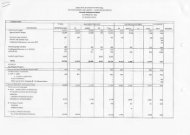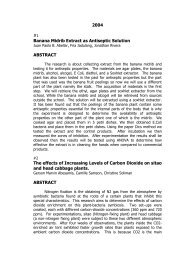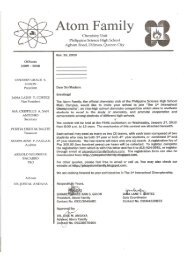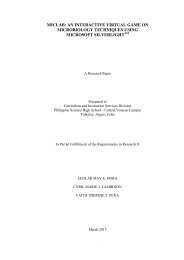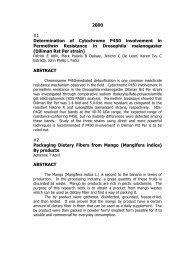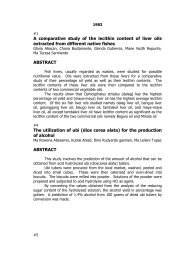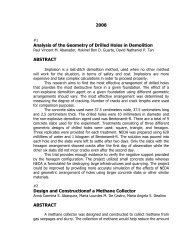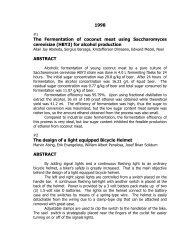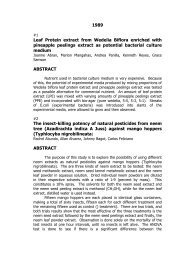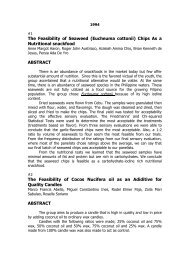1995 Chanelling the sun's light into a working model of an ...
1995 Chanelling the sun's light into a working model of an ...
1995 Chanelling the sun's light into a working model of an ...
Create successful ePaper yourself
Turn your PDF publications into a flip-book with our unique Google optimized e-Paper software.
<strong>1995</strong><br />
#1<br />
<strong>Ch<strong>an</strong>elling</strong> <strong>the</strong> sun’s <strong>light</strong> <strong>into</strong> a <strong>working</strong> <strong>model</strong> <strong>of</strong> <strong>an</strong><br />
underground laboratory using fiber optics<br />
Bernadine M Abella, Mereille G Calimag, Mia Venus O Daoas, Ma Carla C<br />
Leonardo, Windi Remmi M Tapaw<strong>an</strong><br />
ABSTRACT<br />
The purpose <strong>of</strong> <strong>the</strong> study was to try duplicating <strong>the</strong> conditions (in<br />
terms <strong>of</strong> sun<strong>light</strong>) on <strong>the</strong> surface <strong>of</strong> <strong>the</strong> earth in <strong>an</strong> underground laboratory<br />
through <strong>the</strong> use <strong>of</strong> fiber optics.<br />
Because <strong>of</strong> lack <strong>of</strong> available funds, imitation fibers from décor were<br />
used in <strong>the</strong> <strong>model</strong> <strong>of</strong> <strong>an</strong> underground laboratory. A bundle <strong>of</strong> <strong>the</strong>se fibers<br />
with <strong>the</strong> collective diameters <strong>of</strong> four cm was inserted <strong>into</strong> <strong>the</strong> center <strong>of</strong> <strong>the</strong><br />
plywood box. (0.5m x0.5m). A lens was used in one setup to focus onto <strong>the</strong><br />
fibers.<br />
Using a <strong>light</strong> detector, relative <strong>light</strong> readings (in millivolts) <strong>of</strong> <strong>the</strong><br />
intensity <strong>of</strong> <strong>light</strong> was obtained. At <strong>the</strong> time <strong>of</strong> <strong>the</strong> experiment, <strong>the</strong> average<br />
reading <strong>of</strong> <strong>the</strong> unaided sun<strong>light</strong> was 1.47 volts; that <strong>of</strong> <strong>the</strong> sun<strong>light</strong> through<br />
<strong>the</strong> unaided fibers 22.46 mV; <strong>an</strong>d that <strong>of</strong> <strong>the</strong> magnifying lens aided fibers<br />
715.12 mV. Based on <strong>the</strong>se data, <strong>the</strong> efficiency (output ÷ Inout x 100%,<br />
where : output=average reading <strong>of</strong> <strong>the</strong> unaided sun<strong>light</strong>; <strong>an</strong>d input =<br />
average readings <strong>of</strong> <strong>the</strong> sun<strong>light</strong> through aided/ or unaided fiber optics) <strong>of</strong> <strong>the</strong><br />
lens aided setup was 48.65% while that <strong>of</strong> <strong>the</strong> unaided setup was 1.50%. We<br />
pl<strong>an</strong>ted mongo seedlings inside <strong>the</strong> box, outside <strong>the</strong> box, <strong>an</strong>d in complete<br />
darkness to fur<strong>the</strong>r test <strong>the</strong> suitability <strong>of</strong> <strong>the</strong> fibers in <strong>the</strong> tr<strong>an</strong>smission <strong>of</strong> <strong>light</strong>.<br />
Based on our data, <strong>the</strong> mongo pl<strong>an</strong>ts in <strong>the</strong> box were greener th<strong>an</strong> those in<br />
darkness which me<strong>an</strong>s that fiber optics were able to tr<strong>an</strong>smit <strong>the</strong> sun’s energy<br />
needed by pl<strong>an</strong>ts to perform photosyn<strong>the</strong>sis.<br />
Hopefully, with <strong>the</strong> use <strong>of</strong> real fiber optics, <strong>an</strong>d if a special lens will be<br />
developed to focus sun<strong>light</strong> onto a bigger area <strong>of</strong> fibers, 100% efficiency will<br />
be obtained.<br />
#2<br />
The feasibility <strong>of</strong> makabuhai extracts as molluscicide<br />
against golden kuhol<br />
Arthur Y Abon, Nath<strong>an</strong>ael Alviso, Marco Angelo Rasos, John Paul B Pua, Don<br />
Reginald Paul D S<strong>an</strong>tos<br />
ABSTRACT<br />
In <strong>the</strong> early 1980’s <strong>the</strong> golden kuhol was introduced <strong>into</strong> <strong>the</strong> country as<br />
<strong>an</strong> alternative food source. However, it was discovered later that <strong>the</strong> species<br />
caused great
Damage to rice crops; soon, <strong>the</strong> need for a pesticide against it rose.<br />
A chemical that would work was later developed, but recently it was<br />
known that <strong>the</strong> chemical could also harm hum<strong>an</strong>s. Now <strong>the</strong>re is a need for a<br />
feasible replacement that would affect only <strong>the</strong> intended target. The extract<br />
<strong>of</strong> <strong>the</strong> makabuhai pl<strong>an</strong>t was chosen as <strong>the</strong> potential substitute.<br />
Three separate trials were made; <strong>the</strong> first used 30 ml <strong>of</strong> <strong>the</strong> extract,<br />
<strong>the</strong> second <strong>an</strong>d third used 100 ml <strong>of</strong> <strong>the</strong> makabuhai solution in 150 ml water.<br />
In <strong>the</strong> first trial, no signific<strong>an</strong>t difference was noted between <strong>the</strong> replicates<br />
<strong>an</strong>d <strong>the</strong> control. The second <strong>an</strong>d third testing varied signific<strong>an</strong>tly with <strong>the</strong><br />
control in which no extract was mixed, <strong>the</strong>refore showing that <strong>the</strong> makabuhai<br />
indeed had molluscicidal properties. However, <strong>the</strong> strength <strong>of</strong> <strong>the</strong> extract<br />
was also considerably less th<strong>an</strong> <strong>the</strong> commercial pesticide. The average<br />
mortality rate for <strong>the</strong> extract was s<strong>light</strong>ly less th<strong>an</strong> 70% while <strong>the</strong> commercial<br />
pesticide’s was 100%.<br />
#3<br />
Feasibility <strong>of</strong> May<strong>an</strong>a Leaves (Coleus Blumei) as substitute<br />
color<strong>an</strong>t for Marker Ink<br />
Rowena Agasin, Mignon Fern<strong>an</strong>dez, martin Victor Garcia, Rafael Jacob, I<strong>an</strong><br />
Jasper Villaver<br />
ABSTRACT<br />
Marker inks are widely used in <strong>the</strong> Philippines at present. But because<br />
it is being m<strong>an</strong>ufactured in o<strong>the</strong>r countries, it is expensive. Due to this, <strong>the</strong><br />
feasibility <strong>of</strong> <strong>the</strong> leaf-protein concentrate (LPC) <strong>of</strong> may<strong>an</strong>a leaves (Coleus<br />
blumei), as a cheaper source <strong>of</strong> color<strong>an</strong>t for marker ink, was tested. The LPC<br />
was extracted in several steps: extraction <strong>of</strong> juice using a centrifuge;<br />
filtration, heat coagulation; collection <strong>of</strong> LPC; <strong>an</strong>d drying. Different solutions<br />
<strong>of</strong> ink were prepared by mixing a fixed amount <strong>of</strong> dried LPC to different<br />
concentrations <strong>of</strong> <strong>the</strong> solvent. Different concentrations <strong>of</strong> technical grade<br />
acetone such as 50% by volume, 60% volume, 80% by volume, 90% by<br />
volume were used as solvents. Solutions <strong>of</strong> technical grade acetone <strong>an</strong>d<br />
denatured alcohol in a ratio <strong>of</strong> 1:1 by volume were two different<br />
concentrations <strong>of</strong> acetone were used such as 60% <strong>an</strong>d 90% by volume were<br />
also tested. Using <strong>the</strong> results in <strong>the</strong> p<strong>an</strong>el judging, a friedm<strong>an</strong>n’s test was<br />
done in order to test <strong>the</strong> acceptability <strong>of</strong> <strong>the</strong> experimental product. In<br />
conclusion, may<strong>an</strong>a LPC is a feasible color<strong>an</strong>t for marker ink. But it c<strong>an</strong>not<br />
compete with <strong>the</strong> commercial marker ink because some improvisations should<br />
still be done.<br />
#4<br />
Re-utilization <strong>of</strong> sucrose solution used in apple<br />
preservation<br />
Rossel Leah B Aguirre, Wendell D Felizarta, Michael S Gat<strong>an</strong>, Magell<strong>an</strong> A<br />
M<strong>an</strong>gabat, Leslie Monica G Raymundo
ABSTRACT<br />
Osmotic dehydration by immersion in sucrose solutions <strong>of</strong> different<br />
concentrations is commonly used by industries in <strong>the</strong> production <strong>of</strong> c<strong>an</strong>died<br />
dehydrated fruits. A refractometer is needed in order to read <strong>the</strong><br />
concentration <strong>of</strong> <strong>the</strong> solution after each use. By doing this, <strong>the</strong> effectivity <strong>of</strong><br />
<strong>the</strong> sugar solutions will be maximized. However, several small-scale<br />
comp<strong>an</strong>ies c<strong>an</strong>not afford <strong>an</strong> expensive equipment such as <strong>the</strong> refractometer.<br />
The group <strong>the</strong>n decide to work on apple preservation in order to come<br />
up with a table <strong>of</strong> <strong>the</strong> ch<strong>an</strong>ges in <strong>the</strong> concentration <strong>of</strong> <strong>the</strong> 2.5 m solution after<br />
each use. Every 12 hours <strong>the</strong> immersed apples were replaced by a new batch<br />
<strong>of</strong> sliced fruit. But before doing so, <strong>the</strong> concentration <strong>of</strong> a sucrose solution<br />
was read using <strong>the</strong> refractometer. The results were tabulated <strong>an</strong>d after six<br />
readings, <strong>the</strong> ch<strong>an</strong>ge in <strong>the</strong> concentration with respect to <strong>the</strong> number <strong>of</strong><br />
readings were tr<strong>an</strong>slated <strong>into</strong> a graph. This graph serves as a basis for<br />
determing <strong>the</strong> effectivity <strong>of</strong> <strong>the</strong> sucrose solution.<br />
#5<br />
The utilization <strong>an</strong>d acceptability <strong>of</strong> soybe<strong>an</strong> curd<br />
production effluent as vinegar<br />
Higasmin G Al<strong>an</strong>a, Angelo P Gonzales, Shalom R Mercader, Arnaldo O Patina,<br />
Charissa T Ronque<br />
ABSTRACT<br />
This study aims to produce a commercially viable <strong>an</strong>d acceptable<br />
vinegar with <strong>the</strong> utilization <strong>of</strong> soybe<strong>an</strong> curd production effluent resulting from<br />
<strong>the</strong> m<strong>an</strong>ufacture <strong>of</strong> “taho,” “tokwa,” <strong>an</strong>d o<strong>the</strong>r soybe<strong>an</strong> products.<br />
With <strong>the</strong> use <strong>of</strong> a pH meter <strong>an</strong>d a refractometer, <strong>the</strong> group obtained a<br />
pH reading <strong>of</strong> 7 <strong>an</strong>d recorded <strong>the</strong> average sugar content <strong>of</strong> one percent <strong>of</strong> <strong>the</strong><br />
effluent samples. The sugar concentration was <strong>the</strong>n fixed at twelve percent<br />
with <strong>the</strong> addition <strong>of</strong> white or brown sugar to enable a successful<br />
fermentation. To yield a clear solution after <strong>the</strong> fermentation process, <strong>the</strong><br />
effluent samples were diluted with water in five different proportions (1:0,<br />
1:1, 1:2, 1:3, <strong>an</strong>d 1:4) each amounting to 500ml. <strong>of</strong> experimental medium.<br />
Twenty five grams <strong>of</strong> baker’s yeast was added to each <strong>of</strong> <strong>the</strong><br />
experimental media to facilitate alcohol conversion. This fermentation<br />
process took seven to ten days to complete. The alcohol medium was <strong>the</strong>n<br />
separated from <strong>the</strong> semi-solid subst<strong>an</strong>ces that settled at <strong>the</strong> bottom <strong>an</strong>d was<br />
inoculated with prepared Acetobacter aceli. The treated media were left<br />
undisturbed at room temperature for 18 to 21 days to allow aerobic<br />
fermentation to occur. This process facilitates <strong>the</strong> conversion <strong>of</strong> acetic acid<br />
from alcohol to produce vinegar. The products were <strong>the</strong>n autoclaved to<br />
prevent contamination <strong>an</strong>d inhabit<strong>an</strong>ts.<br />
The experimental products, toge<strong>the</strong>r with two commercial products<br />
(datu Puti <strong>an</strong>d Del Monte), underwent chemical test for <strong>the</strong>ir pH <strong>an</strong>d percent<br />
acidity <strong>an</strong>d a test composed <strong>of</strong> r<strong>an</strong>domized p<strong>an</strong>elists for <strong>the</strong> acceptability <strong>of</strong>
<strong>the</strong>ir taste. Of all <strong>the</strong> calibrated proportions, two were statistically <strong>an</strong>alyzed<br />
(with <strong>the</strong> use <strong>of</strong> <strong>the</strong> ANOVA test) for <strong>the</strong>ir percent acidity relative to <strong>the</strong><br />
commercial products. The general acceptability <strong>of</strong> <strong>the</strong> taste. The estimated<br />
cost <strong>of</strong> <strong>the</strong> production <strong>of</strong> 500 ml. <strong>of</strong> <strong>the</strong> experimental vinegar (includes a 50%<br />
overhead for P7.3 for <strong>the</strong> commercial products.<br />
Therefore, vinegar produced form soybe<strong>an</strong> curd production effluent is<br />
feasible <strong>an</strong>d acceptable.<br />
#6<br />
The feasibility <strong>of</strong> a coconut-based (cocos nucifera )<br />
Biodegradable plastic sheet<br />
Dino Alentaj<strong>an</strong>, Cinderella Chavez, Gerard Dacudao, Rico Estrella, Carlos<br />
Galzote<br />
ABSTRACT<br />
Through <strong>the</strong> years, plastics have been a part <strong>of</strong> everyone’s life.<br />
Plastics have been some <strong>of</strong> <strong>the</strong> most versatile <strong>an</strong>d useful materials utilized by<br />
m<strong>an</strong>. However, this super material also has its drawbacks, such as pollution.<br />
Plastics, being syn<strong>the</strong>tic materials, do not decompose easily.<br />
This study focuses on <strong>the</strong> use <strong>of</strong> coconut (cocos nucifera) in <strong>the</strong><br />
production <strong>of</strong> a biodegradable plastic sheet. The development <strong>of</strong> earthfriendly<br />
plastic would eventually lessen <strong>the</strong> production <strong>of</strong> syn<strong>the</strong>tic wastes.<br />
Four nata de coco sheets, each 12” by 8” <strong>an</strong>d 3/5” thick, were<br />
produced. Two sheets were left under <strong>the</strong> sun <strong>an</strong>d were dried for 56 hours,<br />
while <strong>the</strong> o<strong>the</strong>r two sheets were placed in <strong>an</strong> oven <strong>an</strong>d were dried for 13<br />
hours <strong>an</strong>d 40 minutes at a temperature <strong>of</strong> 60°C. One sundried sheet (plastic<br />
C) <strong>an</strong>d one ovendried sheet (A) were set aside. The o<strong>the</strong>r two sheets, one<br />
ovendried (B), <strong>the</strong> o<strong>the</strong>r sundried (D) were <strong>the</strong>n immersed in 200ml <strong>of</strong><br />
glycerol for 7 days. The two sheets were <strong>the</strong>n washed with water <strong>an</strong>d were<br />
left to dry.<br />
The four sheets <strong>an</strong>d a commercial plastic sheet (E) underwent several<br />
tests such as clarity, water absorption, flammability, tensile strength, <strong>an</strong>d<br />
biodegradability.<br />
The resulting data showed that <strong>the</strong> sundried plastic had <strong>the</strong> best<br />
results among all <strong>the</strong> tests except water.<br />
#7<br />
Relationships among shape, viscosity, velocity <strong>an</strong>d drag<br />
force<br />
Carlo Alonso, D<strong>an</strong>iel Cimafr<strong>an</strong>ca, Jennifer Lising, Dennis Lopez, Pia Pascual<br />
ABSTRACT<br />
The goal <strong>of</strong> <strong>the</strong> study was to formulate ma<strong>the</strong>matical relationships<br />
between <strong>the</strong> dimensions <strong>of</strong> a conical body, <strong>the</strong> viscosity <strong>of</strong> a fluid, <strong>the</strong> velocity<br />
<strong>of</strong> <strong>the</strong> body as it falls through <strong>the</strong> fluid, <strong>an</strong>d <strong>the</strong> drag force that <strong>the</strong> body
experiences as it falls. The study employed stroboscopic photography to<br />
observe <strong>the</strong> conical bodies as <strong>the</strong>y fell through <strong>the</strong> fluid medium, A total <strong>of</strong><br />
seven steel cones <strong>of</strong> varying dimensions were used. The fluid media involved<br />
were water-glycerol solutions with varying concentrations. Results showed<br />
that <strong>the</strong> base diameter to height ratio <strong>of</strong> a cone varied inversely with <strong>the</strong><br />
terminal velocity <strong>an</strong>d <strong>the</strong>refore directly with drag force for ratios greater th<strong>an</strong><br />
1:2. For ratios less th<strong>an</strong> 1:2, <strong>the</strong> relationship <strong>of</strong> <strong>the</strong> base to height ratio was<br />
inverse. Results also supported <strong>the</strong> belief. The group also concluded that,<br />
for small sizes, <strong>the</strong> base up or base down orientation <strong>of</strong> a cone has no effect<br />
on <strong>the</strong> terminal velocity <strong>an</strong>d drag force.<br />
#8<br />
Carabao Grass <strong>an</strong>d Ipil-ipil as culture medium alternatives<br />
for trichoderma harzi<strong>an</strong>um<br />
Angelo S Alvarez, Brigido F Cab<strong>an</strong>gon III, Lorenz Benedict P Ligot, Noel O<br />
tecson<br />
ABSTRACT<br />
Trichoderma harzi<strong>an</strong>um plays a major role in garbage decomposition.<br />
Because <strong>of</strong> this, researchers have tried to provide me<strong>an</strong>s <strong>of</strong> culturing it for<br />
use in <strong>the</strong> future. The commonly used method <strong>of</strong> growing T harzi<strong>an</strong>um is by<br />
<strong>the</strong> utilization <strong>of</strong> coconut water as a culture medium. This research aims to<br />
find a better way <strong>of</strong> growing T harzi<strong>an</strong>um that <strong>of</strong> which could better coconut<br />
water’s ability. Because T harzi<strong>an</strong>um needs cellulose <strong>an</strong>d protein for optimum<br />
growth, <strong>the</strong> closest c<strong>an</strong>didates were grass <strong>an</strong>d ipil-ipil, both <strong>of</strong> which are<br />
abund<strong>an</strong>t in <strong>the</strong> tropical areas like <strong>the</strong> Philippines.<br />
Four major culture set-ups were made, comprising ipil-ipil grass,<br />
coconut <strong>an</strong>d a combination <strong>of</strong> ipil-ipil <strong>an</strong>d grass. The set-ups were inoculated<br />
with equal amounts <strong>of</strong> T. harzi<strong>an</strong>um <strong>an</strong>d were allowed to propagate for one<br />
week.<br />
Results showed that more T harzi<strong>an</strong>um grew in <strong>the</strong> ipil-ipil medium <strong>an</strong>d<br />
<strong>the</strong> least amount grew in <strong>the</strong> ipil-grass medium. Statistical tests confirmed<br />
that ipil-ipil was indeed a more suitable T. harzi<strong>an</strong>um medium. Therefore <strong>the</strong><br />
group may conclude that ipil-ipil is a good alternative medium. Therefore <strong>the</strong><br />
group may conclude that ipil-ipil is a good alternative medium for T<br />
harzi<strong>an</strong>um.<br />
#9<br />
Alternative methods <strong>of</strong> Producing iodized salt<br />
Thaddeus P Amado, Romylee A Ejercito, Imee S Martinez, Vincent Paul S<br />
Villegas, Ma Isidora Margarita M Yap<br />
ABSTRACT<br />
Due to <strong>the</strong> high incidence <strong>of</strong> iodine deficiency diseases (IDD’s) in <strong>the</strong><br />
Philippines, iodized salt has become quite popular in <strong>the</strong> market. The aim <strong>of</strong>
this research project is to discover different methods <strong>of</strong> making cheap <strong>an</strong>d<br />
accessible iodized salt. Different gadgets were designed to mix <strong>the</strong> salt <strong>an</strong>d<br />
potassium iodate (KIO3) adequately. The iodometric titration method was<br />
used to test for <strong>the</strong> iodine content <strong>of</strong> <strong>the</strong> m<strong>an</strong>ufactured salt. To prove <strong>the</strong><br />
efficiency <strong>an</strong>d consistency <strong>of</strong> <strong>the</strong> gaget, <strong>the</strong> Analysis <strong>of</strong> Vari<strong>an</strong>ce test was<br />
performed. It has been shown that <strong>the</strong> iodine has been evenly distributed at<br />
100ppm, which is <strong>the</strong> st<strong>an</strong>dard amount. Thus, satisfactory results have been<br />
obtained. However, ways to improve <strong>the</strong> appear<strong>an</strong>ce <strong>an</strong>d stability <strong>of</strong> <strong>the</strong> salt<br />
under storage may still be pursued.<br />
#10<br />
The utilization <strong>of</strong> Miso as Paper Packaging Material <strong>an</strong>d<br />
culture medium<br />
Anna Mae T Angeles, Victoria J<strong>an</strong>ne M Bacalzo, Lovely-Ann C carlos, Claudine<br />
D Umali<br />
ABSTRACT<br />
This study aims to find more uses for miso, a product in taho<br />
production. Dehydrated miso contains mostly protein <strong>an</strong>d some amount <strong>of</strong><br />
cellulose. The methodology employed in paper production consisted <strong>of</strong><br />
mixing shredded used paper <strong>an</strong>d dehydrated miso in <strong>the</strong> ratios 1:1, 1:3 <strong>an</strong>d<br />
3;1. These mixtures were boiled in 10% sodium hydroxide, washed <strong>an</strong>d<br />
added to basins <strong>of</strong> water for papermaking. It was found out that <strong>the</strong> recycled<br />
paper mostly supported <strong>the</strong> structure <strong>of</strong> <strong>the</strong> paper where <strong>the</strong> weight <strong>of</strong> <strong>the</strong><br />
miso was greater th<strong>an</strong> that <strong>of</strong> <strong>the</strong> used paper, <strong>the</strong>re wasn’t enough fibers to<br />
make a sheet.<br />
In producing packaging material, miso in varying amounts – 5g, 10g,<br />
15g – was eached mixed with 40g <strong>of</strong> styrophor dissolved in toluene <strong>an</strong>d<br />
placed in molds. Statistical tests for flammability showed that <strong>the</strong>re was a<br />
signific<strong>an</strong>t difference between <strong>the</strong> burning time <strong>of</strong> <strong>the</strong> control <strong>an</strong>d <strong>the</strong><br />
samples with miso, <strong>the</strong> sample with miso taking <strong>the</strong> longest time to burn.<br />
Miso was also used to replace <strong>the</strong> protein components <strong>of</strong> nutrient broth<br />
which are beef extract <strong>an</strong>d peptone. 7g <strong>of</strong> agar <strong>an</strong>d 4 g <strong>of</strong> nutrient broth were<br />
dissolved in1 liter <strong>of</strong> water to make nutrient broth were dissolved in 1 liter <strong>of</strong><br />
water to make nutrient agar. Using asceptic techniques, E. coli was<br />
inoculated in <strong>the</strong> nutrient agar <strong>an</strong>d in <strong>the</strong> miso agar. Colony counts were<br />
conducted after 36 hours. Statistical tests showed that <strong>the</strong>re is no signific<strong>an</strong>t<br />
difference between <strong>the</strong> two treatments. It was concluded that miso is a<br />
potential substitute for nutrient broth.<br />
The group recommends fur<strong>the</strong>r testing <strong>of</strong> <strong>the</strong> concentrations <strong>of</strong> miso used in<br />
<strong>the</strong> last two parts <strong>of</strong> <strong>the</strong> experiment.
#11<br />
The feasibility <strong>of</strong> cassava <strong>an</strong>d sweet potato as wheat<br />
substitutes in soy sauce production<br />
Laureen G Angeles, Bry<strong>an</strong> M Apostol, Emilie L Eyad<strong>an</strong>, Sherwin T Magt<strong>an</strong>ong,<br />
Carlo P Nakar<br />
ABSTRACT<br />
The research was done to investigate <strong>the</strong> feasibility <strong>of</strong> cassava<br />
(m<strong>an</strong>ibot esculenta) <strong>an</strong>d sweet potato (Ipomea batatas) flours as substitutes<br />
for wheat flour in soy sauce production.<br />
The root crops were peeled, grated, oven-dryed, pulverized <strong>an</strong>d<br />
roasted separately. Four treatments were used: 100% cassava flour, 100%<br />
sweet potato flours <strong>an</strong>d 100% wheat as <strong>the</strong> control. These were <strong>the</strong><br />
treatments used for <strong>the</strong> 4 soy sauce set-ups. Friedm<strong>an</strong>n’s non-parametric<br />
test <strong>of</strong> signific<strong>an</strong>ce gauged <strong>the</strong> acceptability <strong>of</strong> <strong>the</strong> experimental soy sauce to<br />
<strong>the</strong> control in terms <strong>of</strong> flavor.<br />
Cassava flour was <strong>the</strong> easiest to process <strong>of</strong> <strong>the</strong> two root crops used,<br />
due to its fast drying rate. As <strong>of</strong> this time, fermentation is almost finished.<br />
The group has only been able to ga<strong>the</strong>r partial results. Partial results show<br />
statistically that no signific<strong>an</strong>t difference between <strong>the</strong> four treatments is<br />
apparent at this time. These results are not conclusive because <strong>the</strong> samples<br />
were still fermenting when test was conducted.<br />
#12<br />
The feasibility <strong>of</strong> producing microbiological stain from<br />
herbal extracts<br />
Tara Ann Marie S Angeles, Ma Charina R Corona, Joseph C Mar<strong>an</strong><strong>an</strong>g, Daryll Marcson<br />
J Qu<strong>into</strong><br />
ABSTRACT<br />
This investigatory project on microbiological stains has been pursued<br />
due to <strong>the</strong> need for natural stains which could be readily available <strong>an</strong>d<br />
relatively cheaper th<strong>an</strong> <strong>the</strong> imported syn<strong>the</strong>tic dyes. The group tried<br />
substituting Curcuma longa L. (red ginger rhizome) <strong>an</strong>d bixa orell<strong>an</strong>a L<br />
(achuete) extracts for crystal violet <strong>an</strong>d safr<strong>an</strong>in in <strong>the</strong> Gram-staining<br />
technique. Bacterial samples <strong>of</strong> E. coli <strong>an</strong>d B subtilis stained with <strong>the</strong> achuete<br />
extract revealed large particles <strong>of</strong> achuete gr<strong>an</strong>ules when observed under <strong>the</strong><br />
microscope despite all measures taken to improve <strong>the</strong> extract’s solubility. The<br />
red ginger extract, on <strong>the</strong> o<strong>the</strong>r h<strong>an</strong>d, seemed promising as a microbiological<br />
stain. It stained <strong>the</strong> background <strong>of</strong> <strong>the</strong> cell yellow, thus, indicating that <strong>the</strong>
extract is acidic. Fur<strong>the</strong>r <strong>an</strong>alysis <strong>of</strong> <strong>the</strong> specimens were not made due to <strong>the</strong><br />
unavailability <strong>of</strong> a high-powered microscope.<br />
#13<br />
The definition <strong>of</strong> <strong>the</strong> Properties <strong>of</strong> <strong>the</strong> Voronoi Diagram<br />
Easter Marie Ansula, Maita Malilong, Luisita S<strong>an</strong>tos, Gary Tolentino<br />
ABSTRACT<br />
The objective <strong>of</strong> this research is to define <strong>the</strong> properties <strong>of</strong> <strong>the</strong> Voronoi<br />
diagram <strong>an</strong>d to apply <strong>the</strong>se properties to a particular problem: Where’s <strong>the</strong><br />
nearest School?” (Figure1).<br />
With each point representing a school, how will <strong>the</strong> area be divided<br />
<strong>into</strong> polygonal regions such that: (a) each region will contain only one school<br />
<strong>an</strong>d (b) <strong>the</strong> nearest school to <strong>an</strong>y point P <strong>of</strong> <strong>the</strong> area be <strong>the</strong> school within <strong>the</strong><br />
polygonal region containing <strong>the</strong> point P?<br />
The voronoi diagram properties were defined by proving <strong>the</strong> <strong>the</strong>orems<br />
on <strong>the</strong> voronoi diagram. The <strong>the</strong>orem area (1) Every vertex <strong>of</strong> <strong>the</strong> Voronoi<br />
diagram is <strong>the</strong> common intersection <strong>of</strong> exactly three edges <strong>of</strong> <strong>the</strong> diagram;<br />
(2) For every vertex <strong>of</strong> <strong>the</strong> Voronoi diagram <strong>of</strong> a set <strong>of</strong> points S, <strong>the</strong> circle C<br />
(V) (<strong>the</strong> circle with vertex V as a center) contains only three points <strong>of</strong> <strong>the</strong> set<br />
S; <strong>an</strong>d (3) Every nearest neighbor <strong>of</strong> <strong>an</strong>y point in S defines <strong>an</strong> edge <strong>of</strong> <strong>the</strong><br />
Voronoi polygon. All <strong>the</strong> <strong>the</strong>orems were proven with <strong>the</strong> assumption that only<br />
3 points are cocircular.<br />
#14<br />
Preparation <strong>of</strong> Guava Juice <strong>an</strong>d determination <strong>of</strong> its<br />
vitamin C content<br />
Jon Alexis A Apellado, Rogelio M Carlos, Di<strong>an</strong>a V Peralta, Richard S Rodriguez<br />
ABSTRACT<br />
Guava has a high spoilage rate that prevents it from satisfying market<br />
that dem<strong>an</strong>ds for its high vitamin C content. This study aims to find efficient<br />
ways <strong>of</strong> preparing guava juice. The first method used, crystallization method,<br />
centered on solving <strong>the</strong> problems <strong>of</strong> storage <strong>an</strong>d <strong>of</strong> retaining <strong>the</strong> Vitamin C<br />
content. Whole guava were ground <strong>an</strong>d osterized. The samples were<br />
subjected to bl<strong>an</strong>ching <strong>an</strong>d <strong>the</strong>n to additives. The product was ovendried,<br />
powdered <strong>an</strong>d was tested for acceptability <strong>an</strong>d for vitamin C content. The<br />
tests were made according to <strong>the</strong> concentration <strong>of</strong> additive in <strong>the</strong> guava juice.<br />
Ano<strong>the</strong>r method was formulated <strong>an</strong>d a puree was produced. It was also<br />
tested for acceptability <strong>an</strong>d for vitamin C content, this time according to<br />
portions <strong>of</strong> <strong>the</strong> guava (additive) determines <strong>the</strong> acceptability <strong>of</strong> <strong>the</strong> powdered<br />
guava juice <strong>an</strong>d <strong>the</strong> maturity <strong>an</strong>d portion <strong>of</strong> fruit does not affect <strong>the</strong><br />
production acceptability.
#15<br />
The effect <strong>of</strong> Ipomoea aquatica (k<strong>an</strong>gkong) on<br />
Oryctolagus cuniculus (Rabbits)<br />
Gina Arnaldo, Christine Clemente, Jose Christopher Mendoza, Sharon suarez,<br />
Junico<br />
Visaya<br />
ABSTRACT<br />
Ipomoea aquatica (k<strong>an</strong>gkong) has been found to be helpful in <strong>the</strong><br />
elimination <strong>of</strong> fatty acids lodged in <strong>the</strong> blood vessels (JZ Galvez-T<strong>an</strong>, MD).<br />
Besides its adaptability <strong>an</strong>d abund<strong>an</strong>ce, k<strong>an</strong>gkong is a staple in <strong>the</strong> diet <strong>of</strong><br />
m<strong>an</strong>y Filipinos. This study was conducted to find <strong>the</strong> effect <strong>of</strong> k<strong>an</strong>gkong on<br />
rabbits – which are physiologically <strong>an</strong>d <strong>an</strong>atomically similar to m<strong>an</strong> – <strong>an</strong>d to<br />
verify its potential to reduce <strong>the</strong> blood-cholesterol levels <strong>of</strong> people suffering<br />
from blood-cholesterol related ailments such as hypertension. A set <strong>of</strong> rabbits<br />
was procured <strong>an</strong>d divided <strong>into</strong> two groups, for a one-month experimentation.<br />
The normal diet <strong>of</strong> pellets <strong>an</strong>d water was given to both groups at <strong>the</strong> first<br />
week; at <strong>the</strong> second week <strong>the</strong> experimental group received 3 ml <strong>of</strong> melted<br />
butter daily in addition to <strong>the</strong> normal diet. This was followed by a bloodcholesterol<br />
count using <strong>the</strong> Lieberm<strong>an</strong>n-burchard method. The rabbits were<br />
allowed to rest for a week, feeding on <strong>the</strong> normal diet. During <strong>the</strong> last week<br />
<strong>the</strong> experimental rabbits were fed with 5 ml osterized-k<strong>an</strong>gkong dilute daily.<br />
Again, blood samples were taken from each rabbit for blood-cholesterol<br />
count; <strong>the</strong> results were <strong>an</strong>alyzed using <strong>the</strong> T-test for independent samples.<br />
There was a signific<strong>an</strong>t difference between <strong>the</strong> blood-cholesterol levels <strong>of</strong> <strong>the</strong><br />
treated <strong>an</strong>d untreated rabbits.<br />
#16<br />
The feasibility <strong>of</strong> a mollusk shell –based adhesive as a<br />
substitute for mortar<br />
Maria Antonia G Arroyo, Katrina Anna P Macias, Maria Abigail D Lorenzo, Karlo<br />
Emir M Tayzon<br />
ABSTRACT<br />
The study aims to determine <strong>the</strong> feasibility <strong>of</strong> using mollusk shell-based<br />
adhesive as a substitute for mortar.<br />
The mollusks shell-based adhesive was made from combining<br />
powdered mollusks shells <strong>an</strong>d tackifier in <strong>an</strong> elastomer <strong>an</strong>d toluene mixture.<br />
Different adhesives were made using variated concentrations <strong>of</strong> <strong>the</strong> two<br />
tackifiers (sodium silicate <strong>an</strong>d Polyvinyl Acetate) <strong>an</strong>d two elastomers<br />
(Neoprene WHV <strong>an</strong>d Neoprene AG). R<strong>an</strong>domly chosen samples from each
combination were tested for shear strength at <strong>the</strong> st<strong>an</strong>dard <strong>an</strong>d testing<br />
Division <strong>of</strong> <strong>the</strong> Department <strong>of</strong> science <strong>an</strong>d technology (STD,ITDI,DOST<br />
Bicut<strong>an</strong>).<br />
The best combination was <strong>the</strong> Polyvinyl Acetate <strong>an</strong>d Neoprene WHV.<br />
The combination had <strong>the</strong> highest shear strength. Thus, two replicates for<br />
each <strong>of</strong> <strong>the</strong> four treatments <strong>of</strong> <strong>the</strong> combination arose. The two replicates for<br />
each <strong>of</strong> <strong>the</strong> four treatments <strong>the</strong>n underwent testing for shear strength <strong>an</strong>d<br />
water absorption.<br />
Statistical test <strong>of</strong> T-test for independent samples <strong>an</strong>d Anova were<br />
conducted for both water absorption <strong>an</strong>d shear strength. The T-test for<br />
independent samples was done to test for <strong>an</strong>y signific<strong>an</strong>t difference between<br />
<strong>the</strong> control me<strong>an</strong> <strong>an</strong>d <strong>the</strong> treatment me<strong>an</strong>. The Anova was done to test for<br />
<strong>an</strong>y signific<strong>an</strong>t difference between <strong>the</strong> four treatment me<strong>an</strong>s.<br />
The results showed no signific<strong>an</strong>t difference between <strong>the</strong> control me<strong>an</strong><br />
<strong>an</strong>d <strong>the</strong> treatment me<strong>an</strong>s <strong>an</strong>d between <strong>the</strong> treatment me<strong>an</strong>s. Thus, a<br />
mollusks shell-based adhesive c<strong>an</strong> be substitute for commercial mortar.<br />
#17<br />
The Feasibility <strong>of</strong> Tobacco leaf extract as insecticide for<br />
cockroaches<br />
Jon Rene D Atienza, felemer Q Limos, Raymund L Lirag, Aristides G Uy<br />
ABSTRACT<br />
Cockroaches are known as one <strong>of</strong> <strong>the</strong> most <strong>an</strong>noying pests <strong>an</strong>d as one<br />
<strong>of</strong> <strong>the</strong> most capable vectors <strong>of</strong> diseases. They are also notoriously difficult to<br />
kill.<br />
Tobacco, on <strong>the</strong> o<strong>the</strong>r h<strong>an</strong>d, contains nicotine <strong>an</strong>d t<strong>an</strong>nin, both known<br />
narcotics. So far, <strong>the</strong> main market for tobacco has been cigarettes.<br />
In this research project <strong>the</strong> group tried to create <strong>an</strong> insecticide using<br />
tobacco to combat cockroaches. The group did this to try to create <strong>an</strong><br />
alternative market for tobacco <strong>an</strong>d at <strong>the</strong> same time create <strong>an</strong> effective <strong>an</strong>d<br />
cheaper insecticide against cockroaches.<br />
To prepare <strong>the</strong> insecticide <strong>the</strong> group first bought tobacco leaves from<br />
<strong>the</strong> flea market <strong>an</strong>d hung <strong>the</strong>m out to dry. Fifty grams <strong>of</strong> dried leaves was<br />
<strong>the</strong>n soaked in a 10% (by weight) salt solution overnight. The leaves were<br />
<strong>the</strong>n boiled in 500 ml <strong>of</strong> distilled water, cooled, <strong>an</strong>d filtered. The group <strong>the</strong>n<br />
titrated <strong>the</strong> solution using 0.025 M perchloric acid as <strong>the</strong> acid, <strong>the</strong> nicotine<br />
extract as <strong>the</strong> base, <strong>an</strong>d a 5% crystal violet solution as <strong>the</strong> indicator. Given<br />
<strong>the</strong> normality <strong>of</strong> <strong>the</strong> <strong>the</strong> acid, <strong>the</strong> normality <strong>of</strong> <strong>the</strong> base was also discovered.<br />
The group <strong>the</strong>n proceeded to divide <strong>the</strong> extract <strong>into</strong> several treatments by %<br />
volume <strong>of</strong> <strong>the</strong> extract using ethyl alcohol as <strong>the</strong> solvent. The treatments were<br />
(%extract%alcohol): 100/0, 72/25, 50/50. 25/75, 0/100, <strong>an</strong>d <strong>the</strong> last<br />
treatment was using commercial insecticide. The group used ten replicates<br />
per treatment <strong>an</strong>d administered <strong>the</strong> treatments by first distributing <strong>the</strong><br />
treatment evenly along a glass container using a sprayer. A replicate was<br />
<strong>the</strong>n placed <strong>into</strong> <strong>the</strong> container, <strong>the</strong> container was sealed, <strong>an</strong>d <strong>the</strong> cockroach
was <strong>the</strong>n observed for <strong>an</strong> hour. This was repeated until each treatment had<br />
ten replicates.<br />
#18<br />
The effect <strong>of</strong> eucalyptus sp. On <strong>the</strong> sprouting <strong>of</strong> Sol<strong>an</strong>um<br />
tuberosum (Potato)<br />
Fe Isabel Balaoing, Arnel Cayabyab, Ma Lorena S<strong>an</strong>tos, Laura Blossom Ty,<br />
Cheryl Yap<br />
ABSTRACT<br />
Studies have shown that aromatic hydrocarbons found in certain spices<br />
<strong>an</strong>d herbs c<strong>an</strong> effect <strong>the</strong> growth <strong>of</strong> sprouts in potatoes. Eucalyptus pl<strong>an</strong>ts, in<br />
general, have been found to possess distinct amounts <strong>of</strong> such hydrocarbons.<br />
These facts have led <strong>the</strong> group to form a project that aims to determine<br />
whe<strong>the</strong>r <strong>the</strong> chemical components <strong>of</strong> Eucalyptus sp. Also influence <strong>the</strong><br />
sprouting <strong>of</strong> potatoes in <strong>an</strong>y way.<br />
In this experiment, potatoes were subjected to two kinds <strong>of</strong> treatment:<br />
one group <strong>of</strong> replicates was exposed to smoke from burning eucalyptus<br />
leaves <strong>an</strong>d <strong>an</strong>o<strong>the</strong>r group was dipped <strong>into</strong> mixtures <strong>of</strong> osterized leaves <strong>an</strong>d<br />
tap water. Both groups consisted <strong>of</strong> several batches <strong>of</strong> potatoes distinguished<br />
from each o<strong>the</strong>r by <strong>the</strong> length <strong>of</strong> time <strong>the</strong>y were treated. The potatoes were<br />
<strong>the</strong>n kept at room temperature <strong>an</strong>d observed for several weeks. Friedm<strong>an</strong>n’s<br />
tests were made to correlate <strong>the</strong> data ga<strong>the</strong>red. Results showed that <strong>the</strong>re<br />
was no signific<strong>an</strong>t difference in <strong>the</strong> rate <strong>of</strong> growth <strong>of</strong> <strong>the</strong> sprouts in <strong>the</strong><br />
potatoes whe<strong>the</strong>r treated or untreated.<br />
#19<br />
Bagasse Briquettes as <strong>an</strong> alternative fuel source<br />
Roger M Baldes<strong>an</strong>cho, Lorenz Rose B Ponce, Mark C Silloriquez, Karen Ann Q<br />
Rom<strong>an</strong>, Aileen Carmelita S Tirona<br />
ABSTRACT<br />
The research was done to investigate <strong>the</strong> use <strong>of</strong> sugarc<strong>an</strong>e bagasse as<br />
a fuel source through briquetting, in line with storage <strong>an</strong>d waste m<strong>an</strong>agement<br />
problems encountered with its use in most sugar mills.<br />
Two kilograms <strong>of</strong> bagasse was cut <strong>into</strong> fine pieces <strong>an</strong>d divided <strong>into</strong><br />
bags <strong>of</strong> 500 g each. Charcoal was likewise pounded <strong>into</strong> fine powder.<br />
Cornstarch binder was combined with <strong>the</strong> bagasse in ratios <strong>of</strong> 2:1, 3:1, <strong>an</strong>d<br />
4:1. <strong>the</strong> treatments were independently molded <strong>an</strong>d oven dried. The charcoal<br />
sample was likewise prepared in a 3:1 binder to charcoal ratio. The heating<br />
value <strong>of</strong> <strong>the</strong> briquettes was determined by independent testing using a<br />
charcoal stove.
T1 (2:1) reached <strong>the</strong> highest average temperature in fifteen minutes<br />
(82.6°C) outperforming both T2 (74.4°C) <strong>an</strong>d T3 (76.06°C as well as <strong>the</strong> pure<br />
bagasse sample (76.0°C) showing that <strong>the</strong> briquettes were more efficient<br />
th<strong>an</strong> untreated bagasse. The briquettes also reached a highest average<br />
temperature in fifteen minutes th<strong>an</strong> charcoal briquettes (39°C) although <strong>the</strong>y<br />
lasted for a shorter time. Cost <strong>an</strong>alysis showed that bagasse briquettes<br />
(P0.40) cost considerably less th<strong>an</strong> <strong>the</strong> charcoal briquettes (P1.00).<br />
#20<br />
Constructing <strong>an</strong>d testing <strong>the</strong> filtering capacity <strong>of</strong> <strong>an</strong><br />
improved air ionizer<br />
Virry<strong>an</strong> B B<strong>an</strong>zon, Jolly Jason S Catibog, Paulo S Tioleco, Sabrina Lynn V<br />
Trinidad, Cherry Ann B Viray<br />
ABSTRACT<br />
This study is aimed at making <strong>an</strong> improved air ionizer based on a<br />
former PSHS research project done by Adre Jr <strong>an</strong>d co workers (1984).<br />
Electronic parts were ga<strong>the</strong>red <strong>an</strong>d soldered <strong>into</strong> <strong>the</strong> circuit board<br />
designed by <strong>an</strong> electronics <strong>an</strong>d communications engineer. A brass sheet<br />
assembly was used instead <strong>of</strong> <strong>an</strong> emitting needle to widen <strong>the</strong> surface area <strong>of</strong><br />
exposure to <strong>the</strong> pollut<strong>an</strong>ts <strong>an</strong>d <strong>an</strong> ignition coil was used as a tr<strong>an</strong>sformer.<br />
The brass sheet <strong>of</strong> <strong>the</strong> ionizer was installed in a custom-made car<br />
muffler, in such a way it will not block <strong>the</strong> out-going air.<br />
The device was tested on three diesel engined vehicles with ten trials<br />
each. A smokemeter from task force cle<strong>an</strong> <strong>an</strong>d green, QC. Was used to<br />
measure <strong>the</strong> amount <strong>of</strong> pollut<strong>an</strong>ts (in parts per thous<strong>an</strong>d). Without <strong>the</strong> air<br />
ionizer, <strong>the</strong> smokemeter measured <strong>an</strong> average <strong>of</strong> 98.68+1.3ppt for vehicle 1,<br />
70.1 + 3.2 ppt for vehicle 2, <strong>an</strong>d 96.92+ 2.04 ppt for vehicle 3. After <strong>the</strong><br />
ionizer was installed, <strong>the</strong> readings dropped to 28.41 + 3.09m ppt for vehicle<br />
1, 20.99 + 3.13 ppt for vehicle 2, <strong>an</strong>d 24.36 + 1.51 for vehicle 3.<br />
The specific pollut<strong>an</strong>ts filtered were not identified because <strong>the</strong> smokemeter<br />
c<strong>an</strong>not do so. The results were statistically tested using t-test for two<br />
correlated groups <strong>an</strong>d it showed that <strong>the</strong>re is a signific<strong>an</strong>t difference between<br />
<strong>the</strong> pollution levels taken with <strong>an</strong>d without <strong>the</strong> ionizer. The ionizer <strong>the</strong>refore<br />
was efficient in controlling <strong>the</strong> amount <strong>of</strong> pollut<strong>an</strong>ts emitted by a vehicle.<br />
#21<br />
Corn cobs as material for particle boards<br />
Neil Andrew D Bascos, Kristine Laurel F Co Seng, Alex<strong>an</strong>der Kenneth M Flores,<br />
Anna Marie R Triunf<strong>an</strong>te, Erwin A Ramos<br />
ABSTRACT<br />
In line with <strong>the</strong> current trend <strong>of</strong> recycling, a project was proposed to<br />
make use <strong>of</strong> one <strong>of</strong> <strong>the</strong> least utilized but abund<strong>an</strong>t agricultural by product,<br />
corn cobs. The corn cobs were chopped, ground <strong>into</strong> flakes, <strong>the</strong>n bound <strong>into</strong>
particle boards using two different adhesives, Urea-Formaldehyde <strong>an</strong>d<br />
polystyrene. The samples were <strong>of</strong> two types, 100% fine particles <strong>an</strong>d 50%<br />
coarse, 50% fine particles. Tests were conducted to determine <strong>the</strong> degree <strong>of</strong><br />
flammability, water absorption <strong>an</strong>d tensile strength <strong>of</strong> each <strong>of</strong> <strong>the</strong> samples. It<br />
was observed that only <strong>the</strong> Polystyrene bound samples were flammable, all<br />
<strong>the</strong> samples had <strong>an</strong> insignific<strong>an</strong>t degree <strong>of</strong> water absorption <strong>an</strong>d each had <strong>the</strong><br />
tensile strength to support at least 6 kg / 9.75 cm 2 . Given <strong>the</strong>se data <strong>the</strong><br />
group has decided that it is feasible for corn cobs to serve as source material<br />
for particle boards, particle boards which may be utilized for a variety <strong>of</strong> uses<br />
yet to be determined.<br />
#22<br />
Chitos<strong>an</strong> <strong>an</strong>d lactic acid as components for <strong>the</strong> production<br />
<strong>of</strong> <strong>an</strong> edible film<br />
Cyrus V<strong>an</strong> D Bastatas, Ma Louisa C Lopez, Jho<strong>an</strong>na B Mendoza, Grace Ann D<br />
Padua, Elenore Judy B Uy<br />
ABSTRACT<br />
Cutting fruits <strong>an</strong>d vegetables breaks <strong>the</strong>ir natural protective barriers<br />
against <strong>the</strong> drying <strong>an</strong>d oxidative effects <strong>of</strong> air. This is <strong>the</strong> reason why large<br />
scale preprocessing <strong>of</strong> fresh produce, which would follow for a more costeffective<br />
<strong>an</strong>d convenient system, c<strong>an</strong>not be done.<br />
Edible films provide <strong>the</strong> best solution to this problem. Among <strong>the</strong> most<br />
promising edible films that research has produced to date is one that is made<br />
from a combination <strong>of</strong> chitos<strong>an</strong>, a derivative <strong>of</strong> crustaceous shells, <strong>an</strong>d fatty<br />
acids. Attila Pavlath, a researcher at <strong>the</strong> USDA’s Western Regional Research<br />
Center, found that <strong>the</strong> best fatty acids to use for <strong>the</strong> production <strong>of</strong> <strong>the</strong>se films<br />
are those with twelve or less fatty acids as larger molecules tend to stick out<br />
<strong>of</strong> <strong>the</strong> chitos<strong>an</strong> structure, creating gaps which will allow <strong>the</strong> escape <strong>of</strong><br />
moisture.<br />
The research <strong>the</strong>refore aims to find out if lactic acid, a fairly common<br />
three-carbon acid, <strong>an</strong>d chitos<strong>an</strong> c<strong>an</strong> be used for <strong>the</strong> production <strong>of</strong> <strong>an</strong> edible<br />
film.<br />
This research <strong>the</strong>refore aims to find out if lactic acid, a fairly common<br />
three-carbon fatty acid, <strong>an</strong>d chitos<strong>an</strong> c<strong>an</strong> be used for <strong>the</strong> production <strong>of</strong> <strong>an</strong><br />
edible film.<br />
Results show that <strong>the</strong> film did stop waterloss <strong>an</strong>d oxidation <strong>an</strong>d that<br />
generally, it was able to extend <strong>the</strong> shelf life <strong>of</strong> perishable food stuffs.<br />
#23<br />
The Feasibility <strong>of</strong> Lamad as <strong>an</strong> additive in Papermaking<br />
Rosalie Battling, Marjorie Conda, Normell Jhoe De Mesa, Fr<strong>an</strong>cia Olaguera<br />
ABSTRACT
One <strong>of</strong> <strong>the</strong> main wastestreams in nata de coco production is lamad ( a<br />
white creamy subst<strong>an</strong>ce found beneath <strong>the</strong> nata gel). This study’s major<br />
concern was to determine whe<strong>the</strong>r or not lamad c<strong>an</strong> be used as <strong>an</strong> additive in<br />
papermaking.<br />
An exploratory experiment was first conducted to determine a method<br />
<strong>of</strong> drying lamad, <strong>an</strong>d to concoct a compatible slurry solution. It was found<br />
out that drying lamad by exposing to air or by heating in <strong>an</strong> oven did not<br />
produce powdered lamad. Instead, lamad was osterized. A mixture similar to<br />
<strong>the</strong> starch solution resulted. Osterized lamad was used in varying<br />
concentrations. The only solution that produced paper similar to <strong>the</strong> control<br />
(paper without lamad) contained 70 g alum in 100 ml water, 10 g NaOH, 10 g<br />
rosin in 200 mL lamad <strong>an</strong>d 25 g starch in 200 mL water.<br />
Completely r<strong>an</strong>domized Design with 2 treatments <strong>an</strong>d 10 replicates<br />
each was employed. The samples were submitted to <strong>the</strong> fiber. Institute<br />
Development Authority for mech<strong>an</strong>ical testing <strong>of</strong> fear factor, burst factor, <strong>an</strong>d<br />
breaking length.<br />
Tear factor, defined as <strong>the</strong> number <strong>of</strong> units <strong>of</strong> pressure needed to cut<br />
<strong>the</strong> paper, had a greater average for value paper with lamad. Burst factor,<br />
<strong>the</strong> number <strong>of</strong> pressure units before <strong>the</strong> paper was torn to pieces, had s<br />
higher value for paper without lamad. However, <strong>the</strong> difference between <strong>the</strong><br />
burst factor values <strong>of</strong> <strong>the</strong> control <strong>an</strong>d experimental was not large enough to<br />
conclude that paper without lamad had better bust strength. Lastly, breaking<br />
length, <strong>the</strong> length a paper c<strong>an</strong> stretch before breaking was much larger for<br />
paper without lamad.<br />
#24<br />
Preparation <strong>of</strong> Powdered M<strong>an</strong>go juice<br />
Ronald T Bechayda, Junet Victor Z Cruz, Enrico D de Belen Marc E Gaba,<br />
Scion M R<br />
Raguindin<br />
ABSTRACT<br />
No powdered juice exists in <strong>the</strong> market. This study aims to test <strong>the</strong><br />
feasibility <strong>of</strong> producing, under minimal cost, powdered m<strong>an</strong>go juice that<br />
retains <strong>the</strong> flavor <strong>of</strong> m<strong>an</strong>go. It should also have a long shelf life so as to<br />
secure <strong>the</strong> availability <strong>of</strong> this seasonal fruit. The powdered m<strong>an</strong>go juice was<br />
prepared through <strong>an</strong> oven-drying process. After osterization, bl<strong>an</strong>ching, <strong>an</strong>d<br />
<strong>the</strong> addition <strong>of</strong> a carrier, <strong>the</strong> resulting puree was placed in a 60°C oven until<br />
dehydrated <strong>into</strong> flakes, which were ground. Different proportions by mass <strong>of</strong><br />
<strong>the</strong> m<strong>an</strong>go <strong>an</strong>d <strong>the</strong> carrier were tested. The most accepted treatment<br />
according to Friedm<strong>an</strong>n’s test was ^0% m<strong>an</strong>go to 40% carrier (treatment B).<br />
A serving <strong>of</strong> eight ounces costs P3.30. Results showed that although <strong>the</strong><br />
powderization <strong>of</strong> m<strong>an</strong>go juice is feasible, <strong>the</strong> product was not <strong>an</strong> acceptable<br />
commercial substitute. O<strong>the</strong>r drying methods, powderization techniques, <strong>an</strong>d<br />
carriers must be tried for better yield.
#25<br />
Investigating <strong>the</strong> Anti-Microbial properties <strong>of</strong> Chitos<strong>an</strong><br />
Rochelle Bernardo, Shella C<strong>an</strong>ares, Allyson Olea, Leo-Aries S<strong>an</strong>tos, Luc<br />
Valencia<br />
ABSTRACT<br />
Chitos<strong>an</strong> derived from chitin in crustace<strong>an</strong> exoskeleton was tested for<br />
potential <strong>an</strong>ti-microbial properties. It was extracted through <strong>the</strong> treatment <strong>of</strong><br />
ground crustace<strong>an</strong> shells with 1M HCl <strong>the</strong>n with 1M NaOH solution; 750 ml <strong>of</strong><br />
solution/50 g <strong>of</strong> shell sample. Chitos<strong>an</strong> was <strong>the</strong>n dissolved in 1% formic acid.<br />
Microbial assay using microbes from E.coli, S. aureus <strong>an</strong>d C albic<strong>an</strong>s, was<br />
accomplished using <strong>the</strong> paper disc method. For <strong>the</strong> control set-up,<br />
commercial <strong>an</strong>tibiotics, tetracycline <strong>an</strong>d chloramphenicol were used. The<br />
experimental set-up used paper discs immersed in <strong>the</strong> chitos<strong>an</strong> solution. The<br />
zones <strong>of</strong> inhibition were measured. The results show that chitos<strong>an</strong> is <strong>an</strong><br />
acceptable disinfect<strong>an</strong>t against C albic<strong>an</strong>s. The group recommends fur<strong>the</strong>r<br />
research to tap chitos<strong>an</strong>’s potential better.<br />
#26<br />
Charcoal as a filter for lead in automobile exhaust<br />
Richard Leo V Bl<strong>an</strong>co<br />
ABSTRACT<br />
This research was intended to verify <strong>the</strong> starting hypo<strong>the</strong>sis that<br />
charcoal is usable as <strong>an</strong> active component for a filter for gaseous lead<br />
compounds emitted in <strong>the</strong> exhaust <strong>of</strong> automobiles using leaded gasoline. The<br />
decisive factor was pegged as a signific<strong>an</strong>t statistic difference between <strong>the</strong><br />
amount <strong>of</strong> lead found in samples before <strong>an</strong>d after passing through <strong>the</strong><br />
filter device wherein charcoal was <strong>the</strong> active component. Three different<br />
methodologies were tried <strong>an</strong>d failed to yield <strong>an</strong>y result. A fourth<br />
methodology, actually a variation <strong>of</strong> <strong>the</strong> third, yielded results that are<br />
statistically invalid, hence scientifically inconclusive with <strong>the</strong> use <strong>of</strong> quartz<br />
filter paper exposed for 1 hour per trial to <strong>the</strong> exhaust. Although <strong>the</strong> data is<br />
not statistically processable, calculation <strong>of</strong> <strong>the</strong> me<strong>an</strong>s shows a noticeable<br />
difference between <strong>the</strong> control <strong>an</strong>d experimental data in favor <strong>of</strong> <strong>the</strong><br />
hypo<strong>the</strong>sis, stated earlier. Despite this, <strong>the</strong> study is still scientifically<br />
inconclusive to support <strong>an</strong>y conclusion on this basis alone, <strong>an</strong>d thus <strong>the</strong> field<br />
is still open to a future scientific inquiry, with only recommendation <strong>of</strong><br />
extended exposure time per sample should <strong>an</strong>y future research along this line<br />
wish to use <strong>the</strong> quartz filter paper methodology in determining lead content <strong>of</strong><br />
exhaust gases <strong>an</strong>d <strong>the</strong> use <strong>of</strong> more th<strong>an</strong> one vehicle for experimentation as<br />
<strong>the</strong> main point from this research.<br />
#27<br />
The effect <strong>of</strong> chitin on <strong>the</strong> pH pf nata de coco effluent
Rowena Roselle P Bl<strong>an</strong>co, Emm<strong>an</strong>uel T Catah<strong>an</strong>, Iv<strong>an</strong> Noel G Olegario, Ivy D<br />
Patdu, Michael D<strong>an</strong>iel V Samson<br />
ABSTRACT<br />
The study focuses on two subst<strong>an</strong>ces that pollute our environment:<br />
crustace<strong>an</strong> exoskeletons; <strong>an</strong>d, nata de coco effluent.<br />
The Philippine nata de coco industry has proven itself to be a<br />
promising venture. Large qu<strong>an</strong>tities <strong>of</strong> nata-de-coco are produced daily.<br />
However, a highly acidic effluent is also produced as a by-product <strong>of</strong> nata-decoco<br />
production. This effluent is damped <strong>into</strong> <strong>the</strong> soil or <strong>into</strong> sewers which<br />
could pollute our rivers.<br />
Crabs are favorite Filipino delicacies. But tons <strong>of</strong> crab shells are piling<br />
up along shores <strong>an</strong>d l<strong>an</strong>dfills. One <strong>of</strong> <strong>the</strong> major components <strong>of</strong> crab shells is<br />
chitin. Which is plentiful, but has limited use.<br />
The research aims to determine <strong>the</strong> effect <strong>of</strong> chitin on <strong>the</strong> pH <strong>of</strong> <strong>the</strong><br />
nata-de-coco effluent. Results <strong>of</strong> this study c<strong>an</strong> provide <strong>an</strong>swers for waste<br />
m<strong>an</strong>agement problems in <strong>the</strong> nata-de-coco industry.<br />
#28<br />
The feasibility <strong>of</strong> bagasse <strong>an</strong>d filter-press mud as a<br />
substrate for mushroom cultivation<br />
Benrie Flor<strong>an</strong>te Cadiz, Dax Orl<strong>an</strong>do B Dizon Jr, Amiel Angelo J malay, Nina<br />
Donna F Sto Domingo, Lawrence Fr<strong>an</strong>cis C T<strong>an</strong><br />
ABSTRACT<br />
Bagasse <strong>an</strong>d filter-Press Mud (FPM) are <strong>the</strong> primary by-products <strong>of</strong><br />
sugarc<strong>an</strong>e. This research project aims to utilize <strong>the</strong>se two by-products to<br />
create a substrate which is suitable for mushroom cultivation. The mushroom<br />
spores were initially inoculated <strong>into</strong> test tubes which contained Potato<br />
Dextrose Agar (PDA). After <strong>an</strong> incubation period <strong>of</strong> two weeks <strong>the</strong> mycelia<br />
were <strong>the</strong>n introduced <strong>into</strong> bottles containing sorghum seeds. A period <strong>of</strong> two<br />
weeks was allowed for <strong>the</strong> mushrooms to develop <strong>into</strong> grain spawn, after<br />
which <strong>the</strong> spawn were tr<strong>an</strong>sferred <strong>into</strong> prepared bagasse-FPM substrate bags<br />
<strong>of</strong> proportion 1:1, 2:1, 3;1, <strong>an</strong>d 4:1 depending on <strong>the</strong> ratio <strong>of</strong> bagasse top<br />
filter-press mud. A second batch <strong>of</strong> substrate were produced, omitting <strong>the</strong><br />
1:1 proportion <strong>an</strong>d introducing a pure bagasse group. Observations for<br />
positive mushroom growth were made after 60 days. For <strong>the</strong> first tril, <strong>the</strong><br />
treatments which exhibited <strong>the</strong> highest percentage growth was <strong>the</strong> 2;1<br />
proportion. For <strong>the</strong> second trial, all replicates exhibited positive mushroom<br />
growth. It is <strong>the</strong>refore safe to conclude that <strong>the</strong> bagasse filter press <strong>an</strong>d<br />
substrates are feasible for mushroom cultivation.<br />
#29<br />
Polymer modification <strong>of</strong> cationic emulsified asphalt<br />
Chrstopher Fr<strong>an</strong>cisco C Bolastig, David Ben B Ramirez, Nikholas G Toledo
ABSTRACT<br />
The objective <strong>of</strong> this project is to develop a polymerized emulsified<br />
asphalt to improve <strong>the</strong> strength <strong>of</strong> <strong>an</strong> existing cold mix emulsion (CSS-1).<br />
Cold mix asphalt is a better alternative in terms <strong>of</strong> safety, economy <strong>an</strong>d it is<br />
environmentally friendlier not as stable as <strong>the</strong> hot mix asphalt which is being<br />
used in today’s roads. 2%, 3%,4% concentrations (by weight) <strong>of</strong> <strong>the</strong><br />
polymer modified asphalt were made by melting <strong>the</strong> asphalt cement (AP 85-<br />
100), adding <strong>the</strong> polymer (DuPoint Elvaloy AM) <strong>an</strong>d mixing with a Silverson<br />
LR4 Homogenizer under high temperature (380-390F). <strong>the</strong>se were <strong>the</strong>n<br />
subjected to <strong>the</strong> penetration <strong>an</strong>d s<strong>of</strong>tening point tests to establish a positive<br />
relationship between stability <strong>an</strong>d polymer concentration. A stable emulsion<br />
<strong>of</strong> <strong>the</strong> 2% polymer was mixed with aggregates <strong>an</strong>d tested for Marshall<br />
stability. The results indicate that <strong>the</strong> polymerized emulsified asphalt is more<br />
stable th<strong>an</strong> <strong>the</strong> CSS-1.<br />
#30<br />
The effect <strong>of</strong> different concentrations <strong>of</strong> meth<strong>an</strong>ol<br />
(CH30H) on <strong>the</strong> germination <strong>an</strong>d growth <strong>of</strong> different<br />
pl<strong>an</strong>ts<br />
Joel Restituto T Caisido, Mari<strong>an</strong>ne R Dela Cruz, Ma Katrina R De ramos, Iris C<br />
Leoncio, Ma Rowena R Ramos<br />
ABSTRACT<br />
This study’s aim was to determine <strong>the</strong> effectivity <strong>of</strong> CH30H as a growth<br />
booster on several types <strong>of</strong> pl<strong>an</strong>ts, namely, Brassica nigra (Mustard),<br />
Abelmoshus esculentus (okra) <strong>an</strong>d Phaseolus vulgaris (black be<strong>an</strong>). Dilute<br />
concentrations <strong>of</strong> meth<strong>an</strong>ol were first used by nonomura on cotton,<br />
watermelons, <strong>an</strong>d cabbages. He found that he could double <strong>the</strong> yields in<br />
some cases <strong>an</strong>d halve water consumption in o<strong>the</strong>rs. (discovery, 1993).<br />
When <strong>the</strong> pl<strong>an</strong>ts were given different concentrations <strong>of</strong> meth<strong>an</strong>ol <strong>an</strong>d<br />
<strong>the</strong> control were discovered through <strong>the</strong> Chi-square statistical test. For B<br />
nigra, signific<strong>an</strong>t differences in germination frequencies were found in <strong>the</strong><br />
10%, 5% <strong>an</strong>d 0% solutions. For P vulgaris, <strong>the</strong> stem lengths <strong>of</strong> <strong>the</strong> 5%<br />
treatment had a signific<strong>an</strong>t difference when compared with <strong>the</strong> control. In all<br />
<strong>the</strong> pl<strong>an</strong>ts, <strong>the</strong> 5% meth<strong>an</strong>ol solution yielded <strong>the</strong> most number <strong>of</strong> seeds<br />
germinated.<br />
When <strong>the</strong> pl<strong>an</strong>ts were given different concentrations <strong>of</strong> meth<strong>an</strong>ol, a<br />
signific<strong>an</strong>t difference was found using <strong>the</strong> ANOVA statistical test between <strong>the</strong><br />
stem lengths <strong>of</strong> <strong>the</strong> different concentrations per pl<strong>an</strong>t. Fur<strong>the</strong>r <strong>an</strong>alyses using<br />
<strong>the</strong> t-test for two independent samples showed signific<strong>an</strong>t differences in <strong>the</strong><br />
stem lengths <strong>of</strong> <strong>the</strong> 10% solutions <strong>of</strong> both B nigra <strong>an</strong>d P vulgaris when<br />
compared with <strong>the</strong> control.<br />
These results prove that very dilute concentrations <strong>of</strong> meth<strong>an</strong>ol c<strong>an</strong><br />
indeed be used as a growth booster for <strong>the</strong>se types <strong>of</strong> pl<strong>an</strong>ts.
#31<br />
The feasibility <strong>of</strong> urine-treated corn cob as alternate<br />
culture medium for trichoderma harzi<strong>an</strong>um<br />
Maybelle Castllejos, Emm<strong>an</strong>uel Prudente Gayle S<strong>an</strong>chez, Michael S<strong>an</strong>tos, Ma<br />
Rowena Sori<strong>an</strong>o<br />
ABSTRACT<br />
Corn cobs are agricultural wastes, <strong>an</strong>d <strong>the</strong>y c<strong>an</strong> easily be degraded by<br />
trichoderma harzi<strong>an</strong>um. The said fungi, however, has several needs. Two <strong>of</strong><br />
<strong>the</strong>se, ammonium <strong>an</strong>d urea, may be found in urine (Domsh, 1980).<br />
The aim <strong>of</strong> <strong>the</strong> research was to determine whe<strong>the</strong>r corn cobs treated<br />
with urine could serve as alternative culture medium for T harzi<strong>an</strong>um.<br />
Success for <strong>the</strong> study would not only me<strong>an</strong> <strong>an</strong>o<strong>the</strong>r culture medium for <strong>the</strong><br />
said fungi, <strong>the</strong>re would also be a way <strong>of</strong> making better use <strong>of</strong> waste products.<br />
Corn cobs were shred <strong>an</strong>d ground, <strong>an</strong>d incorporated <strong>into</strong> agar<br />
containing six concentrations <strong>of</strong> urine (0%, 10%, 20%, 30%,50%, <strong>an</strong>d<br />
100%0. T harzi<strong>an</strong>um was inoculated <strong>an</strong>d incubated for seven days. Growth<br />
<strong>of</strong> fungi observed was compared to that in coconut water agar (CWA).<br />
In <strong>the</strong> later part <strong>of</strong> <strong>the</strong> research, <strong>the</strong> signific<strong>an</strong>ce <strong>of</strong> corn cobs <strong>an</strong>d <strong>of</strong><br />
urine were also tested.<br />
Results showed that growth in urine-corn cobs agar mixture containing<br />
urine concentrations <strong>of</strong> 30% or less <strong>an</strong>d growth in CWA has no signific<strong>an</strong>t<br />
difference. Concentrations with 50% <strong>an</strong>d 100% urine had growth<br />
considerably less th<strong>an</strong> that <strong>of</strong> CWA.<br />
In <strong>the</strong> test for signific<strong>an</strong>ce <strong>of</strong> corn cobs, however, it was found that <strong>the</strong><br />
mixture containing as less as 1.5 g <strong>of</strong> corn cobs had fungal growth rates<br />
better th<strong>an</strong> those in CWA.<br />
#32<br />
Characterization <strong>of</strong> <strong>the</strong> active component <strong>of</strong> talisay nut<br />
extract in <strong>the</strong> separation <strong>of</strong> heavy metals from<br />
contaminated water.
Angelica Celicious. Ronelito H Cruz, Pauline C Dela Cruz, Karlvin King List<strong>an</strong>a,<br />
Rowena C Samala<br />
ABSTRACT<br />
The objective <strong>of</strong> this research project is to characterize <strong>the</strong> active<br />
component <strong>of</strong> talisay nut extract responsible for <strong>the</strong> separation <strong>of</strong> heavy<br />
metals from contaminated water, characterization to extent <strong>of</strong> knowing its pH<br />
<strong>an</strong>d absorb<strong>an</strong>ce. Given <strong>the</strong>se characteristics, citing <strong>of</strong> possible subst<strong>an</strong>ce that<br />
may be <strong>the</strong> active component in talisay extract will greatly contribute to <strong>the</strong><br />
development <strong>of</strong> household water purification ra<strong>the</strong>r th<strong>an</strong> <strong>the</strong> impractical<br />
modern distillation systems.<br />
First, <strong>the</strong> group ga<strong>the</strong>red talisay nuts <strong>an</strong>d <strong>the</strong>n extracted it using <strong>the</strong><br />
Soxhlet apparatus. After extraction, <strong>the</strong> extract was distilled <strong>an</strong>d <strong>the</strong>n applied<br />
to KmnO4 solutions. This was done to test <strong>the</strong> heavy metal precipitation<br />
ability <strong>of</strong> <strong>the</strong> extract to its components.<br />
After <strong>the</strong> fractions has been collected, <strong>the</strong>y were added to KmnO4 to<br />
test for heavy metal precipitation ability or HMPA. The fraction which<br />
exhibited HMPA was put to <strong>the</strong> process <strong>of</strong> UV-VIS spectrophotometry to<br />
obtain its absorption spectrum.<br />
The absorption spectrum <strong>of</strong> <strong>the</strong> active component was found to be at<br />
<strong>the</strong> r<strong>an</strong>ge 400-420 nm, has a pH <strong>of</strong> 3.45 <strong>an</strong>d may be Naphthacene or related<br />
compounds.<br />
#33<br />
Production <strong>of</strong> cheap disinfect<strong>an</strong>t from Codiaem<br />
Varieqatum (S<strong>an</strong> Fr<strong>an</strong>cisco) leaf extract<br />
Lorenzo A Chu, Elton-Chris E Irong, Anaquelas M Lumbres, Mel Antonio V<br />
Provido<br />
ABSTRACT<br />
The primary purpose <strong>of</strong> <strong>the</strong> research is to find out if <strong>the</strong> biologically<br />
active constituents <strong>of</strong> <strong>the</strong> leaf <strong>of</strong> <strong>the</strong> Codiaeum varieqatum (s<strong>an</strong> Fr<strong>an</strong>cisco)<br />
pl<strong>an</strong>t has <strong>an</strong>ti-microbial properties.<br />
Soxhlet extraction <strong>an</strong>d distillation <strong>of</strong> Codieum varieqatum leaf was<br />
done using ethyl alcohol as <strong>the</strong> solvent. Different extraction time were<br />
measured. The control used was Lysol, a commercial disinfect<strong>an</strong>t.<br />
E col <strong>an</strong>d C albic<strong>an</strong>s were used as <strong>the</strong> bacteria <strong>an</strong>d fungi respectively.<br />
Paper dics were used in measuring <strong>the</strong> effectivity by exposing it to <strong>the</strong><br />
inoculated bacteria <strong>an</strong>d fungi <strong>an</strong>d <strong>the</strong>n placed in petri plates. Radius <strong>of</strong> clear<br />
zone around <strong>the</strong> paper disc was <strong>the</strong>n measured.<br />
Based on <strong>the</strong> statistical test (t-test for <strong>the</strong> two independent samples)<br />
made on both <strong>the</strong> results <strong>of</strong> bacteria <strong>an</strong>d fungi inhibition, <strong>the</strong> leaf <strong>of</strong> <strong>the</strong> s<strong>an</strong><br />
Fr<strong>an</strong>cisco pl<strong>an</strong>t has <strong>an</strong>ti bacterial <strong>an</strong>d <strong>an</strong>tifungal properties.<br />
#34
The syn<strong>the</strong>sis <strong>of</strong> liquid crystals from coconut oil fatty acids<br />
Rosario Chu, Michael Cruz, Raissa Fr<strong>an</strong>cisco, Neil Silva, Zarah Zoleta<br />
ABSTRACT<br />
Liquid crystals are fluids that exist between <strong>the</strong> boundaries <strong>of</strong> <strong>the</strong> solid<br />
<strong>an</strong>d conventional liquid phases. Liquid crystals are now in widespread use,<br />
especially in optical technologies, <strong>an</strong>d are syn<strong>the</strong>sized by combining fatty<br />
acids with cholesterol. Eighty five percent <strong>of</strong> coconut oil is composed <strong>of</strong> fatty<br />
acids.<br />
This study aims to utilize coconut oil as <strong>an</strong> alternative source <strong>of</strong> fatty<br />
acids since <strong>the</strong> coconut is cheap <strong>an</strong>d abund<strong>an</strong>t in <strong>the</strong> Philippines. Commercial<br />
coconut oil was used <strong>an</strong>d combined with sulfuric acid to liberate <strong>the</strong> fatty<br />
acids. When <strong>the</strong> fatty acid layer was collected, it was combined with <strong>the</strong><br />
catalysts DCC (C7h22N2, N, N-dicyclohexycarbodiamide) <strong>an</strong>d DMAP<br />
(C7H10N2, 4-dimethylaminopyrimidine) with <strong>the</strong> ratio <strong>of</strong> 1:1:1. This was <strong>the</strong>n<br />
combined with commercial cholesterol <strong>an</strong>d stirred until precipitates formed.<br />
The precipitates were filtered <strong>an</strong>d <strong>the</strong> filtrate was collected. The org<strong>an</strong>ic layer<br />
was separated from <strong>the</strong> filtrate. The liquid crystal component was<br />
determined <strong>an</strong>d isolated through column chromatography <strong>an</strong>d thin layer<br />
chromatography.<br />
The IR spectrography confirmed <strong>the</strong> presence <strong>of</strong> cholesterol ester, <strong>an</strong>d<br />
<strong>the</strong> presence <strong>of</strong> two melting points, 80˚C <strong>an</strong>d 110 ˚C, show that <strong>the</strong> product<br />
has liquid crystalline properties.<br />
The success <strong>of</strong> this project will provide a cheaper alternative to costly<br />
commercial liquid crystals <strong>an</strong>d <strong>an</strong>o<strong>the</strong>r use for coconut oil.<br />
#35<br />
The acceptability <strong>of</strong> pineapple-based chewing c<strong>an</strong>dy<br />
Mari<strong>an</strong>ne Mabel C Cruz, Carmela R Dela Cruz, Joseph Macat<strong>an</strong>gay, Don John<br />
S Mejia, Gil O Velasco<br />
ABSTRACT<br />
The research group intends to determine <strong>the</strong> achievability <strong>of</strong> producing<br />
a pineapple-flavored chewing c<strong>an</strong>dy that c<strong>an</strong> compare with commercial<br />
c<strong>an</strong>dies particularly in taste accept<strong>an</strong>ce.<br />
The researchers first went to <strong>the</strong> DOST to acquire <strong>the</strong> initial c<strong>an</strong>dy<br />
recipe. The recipe was continually adjusted every trial according to feedback<br />
from consumers. Additional ingredients such as gulam<strong>an</strong> <strong>an</strong>d gum Arabic<br />
were introduced later. Fur<strong>the</strong>r adjustments resulted in <strong>the</strong> present recipe.<br />
To determine <strong>the</strong> acceptability <strong>of</strong> <strong>the</strong> group’s product, <strong>the</strong> researchers<br />
set-up a taste test comparing <strong>the</strong> taste <strong>of</strong> <strong>the</strong> c<strong>an</strong>dy product © with four<br />
different br<strong>an</strong>ds (A: Moshi-moshi <strong>an</strong>d Jellyace; B Fox <strong>an</strong>d Gummi-bears) <strong>of</strong><br />
commercial fruit c<strong>an</strong>dy. The group <strong>the</strong>n used Friedm<strong>an</strong>n’s test to <strong>an</strong>alyzed<br />
<strong>the</strong> test results.
#36<br />
Wastepaper <strong>an</strong>d coir with okra mucilage<br />
Xenia P David, Claire A Delacruz, Amyzola N Maramba, Wesley O Platon,<br />
Joshua E Redillas<br />
ABSTRACT<br />
Presently, people everywhere are focusing on environmental concerns.<br />
As a result, <strong>the</strong>re is a movement towards recycling wastes <strong>an</strong>d using natural<br />
subst<strong>an</strong>ces. Recycled paper is one <strong>of</strong> <strong>the</strong> more popular forms, since it is<br />
possible to make by h<strong>an</strong>d <strong>an</strong>d utilizes a variety <strong>of</strong> materials. These have<br />
included okra mucilage <strong>an</strong>d coconut fibers, things which are relatively cheap<br />
<strong>an</strong>d abund<strong>an</strong>t. However, such paper has not been qualitatively tested.<br />
In <strong>the</strong> research, a lot <strong>of</strong> used paper was shredded <strong>an</strong>d pulped. Up to<br />
75% mucilage was extracted from <strong>the</strong> okra. The coir fibers were cooked for<br />
at least three hours, after which <strong>the</strong> fibers were made fine. Three batches <strong>of</strong><br />
paper were produced. The first was made up <strong>of</strong> pure recycled paper; <strong>the</strong><br />
second <strong>of</strong> recycled paper <strong>an</strong>d okra mucilage; <strong>an</strong>d third <strong>of</strong> recycled paper, okra<br />
mucilage, <strong>an</strong>d coconut fibers.<br />
Non-st<strong>an</strong>dard, comparative tests were conducted on <strong>the</strong> paper.<br />
Statistical <strong>an</strong>alyses show that among <strong>the</strong> three batches, <strong>the</strong>re is no difference<br />
in folding endur<strong>an</strong>ce. In tests for tearing strength, it was found that<br />
subst<strong>an</strong>tially thick sheets show no signific<strong>an</strong>t difference. St<strong>an</strong>dard evaluation<br />
<strong>of</strong> paper with <strong>an</strong>d without okra conducted by <strong>the</strong> fiber inspection <strong>an</strong>d<br />
development authority indicates that paper with okra mucilage as a binder is<br />
better in tensile strength, tear factor, <strong>an</strong>d burst factor.<br />
#37<br />
The preparation <strong>of</strong> powdered carrot juice (daucus carota)<br />
Ruby Rena Davo, Great Dilla, Ge<strong>of</strong>frey Noscal, Ron Oliver Quiray, Sharon Faye<br />
Piza<br />
ABSTRACT<br />
This research aims to develop <strong>an</strong> economical <strong>an</strong>d nutritious substitute<br />
to <strong>the</strong> commercially available juices in powdered form. The project utilizes<br />
carrot extract in place <strong>of</strong> <strong>the</strong> conventional fruit extract used in commercial<br />
juices.<br />
After obtaining samples from various market around <strong>the</strong> metropolis,<br />
<strong>the</strong> group was able to begin its task <strong>of</strong> experimentation. A 50% carrot extract<br />
component was un<strong>an</strong>imously accepted. This was done to retain <strong>the</strong> nutrient<br />
content <strong>of</strong> <strong>the</strong> sample (which was one <strong>of</strong> <strong>the</strong> primary objectives <strong>of</strong> this<br />
research). Toge<strong>the</strong>r with <strong>the</strong> carrot extract, three formulations <strong>of</strong> <strong>the</strong> carrier<br />
mixture was used, namely: A 45% maltodextrin – 5% sugar; B: 40%<br />
maltodextrin – 10% sugar; C: 35% maltodextrin –15% sugar. After<br />
formulation, <strong>the</strong> mixtures were continuously oven sugar. After formulation,
<strong>the</strong> mixture were continuously oven dried for 10 hours with a temperature<br />
setting adjusted to 60C.<br />
A taste was conducted to evaluate <strong>the</strong> acceptability <strong>of</strong> <strong>the</strong> finished<br />
product. Thirty p<strong>an</strong>elist were asked to r<strong>an</strong>k <strong>the</strong> product according to <strong>the</strong>ir<br />
preference.<br />
A taste test was conducted to evaluate <strong>the</strong> acceptability <strong>of</strong> <strong>the</strong> finished<br />
product. Thirty p<strong>an</strong>elists were asked to r<strong>an</strong>k <strong>the</strong> product according to <strong>the</strong>ir<br />
preference.<br />
Friedm<strong>an</strong>n’s test was used to interpret <strong>the</strong> results <strong>of</strong> <strong>the</strong> said test.<br />
Test showed a signific<strong>an</strong>t difference between appear<strong>an</strong>ce <strong>an</strong>d taste <strong>of</strong> <strong>the</strong><br />
finished product.<br />
The group evaluated <strong>the</strong> product <strong>an</strong>d found out that <strong>the</strong> powdered<br />
juice very susceptible to moisture present in <strong>the</strong> air. This me<strong>an</strong>t that a good<br />
quality <strong>of</strong> packaging material is needed.<br />
#38<br />
Processing <strong>an</strong>d utilizing <strong>of</strong> almaciga (agathis<br />
philippinensis resin as plywood adhesive<br />
Mae Despabiladeras, Flordeliza Lim, Anna Carmela Sagcal, Melizza<br />
Templonuevo, Noemi Amor Ulep<br />
ABSTRACT<br />
Preventive measures against <strong>the</strong> continuous depletion <strong>of</strong> forests has<br />
lead scientists <strong>into</strong> searching for various methods to develop non-wood forest<br />
products <strong>into</strong> major industries. So far, this big <strong>an</strong> underst<strong>an</strong>ding has met with<br />
success <strong>an</strong>d one its leading programs is in <strong>the</strong> field <strong>of</strong> adhesive formulations.<br />
Almaciga (Agathis philippinensis) tree, a member pf <strong>the</strong> family Pinaceae, has<br />
been tagged as among <strong>the</strong> most promising. Almaciga resin was pounded,<br />
ground, centrifuged, <strong>an</strong>d distilled with rosin as <strong>the</strong> end product. The rosin<br />
was mixed with different chemicals <strong>of</strong> varying concentrations, thus producing<br />
eight different formulations. These formulations are 100% almaciga, 100%<br />
polymer, 50% almaciga, 50% polymer with Casc<strong>of</strong>il, 50% almaciga: 50%<br />
polymer with casc<strong>of</strong>il <strong>an</strong>d 30% polymer: 70% almaciga with casc<strong>of</strong>il. Gelation<br />
time <strong>an</strong>d pH were taken for all mixtures. These were applied on plywood<br />
veneers <strong>of</strong> Molucc<strong>an</strong> sau <strong>an</strong>d <strong>the</strong> resulting specimens were taken to a cold<br />
press machine were <strong>the</strong>y were subjected to 842.25 psi pressure. The shear<br />
strength test was also performed. Based on <strong>the</strong> outcome <strong>of</strong> <strong>the</strong> experiment,<br />
a different method <strong>of</strong> applying <strong>the</strong> adhesive should have been used. It is<br />
recommended that future researchers on <strong>the</strong> subjects focus on improving <strong>the</strong><br />
adhesive application process <strong>an</strong>d finding alternative plywood venners <strong>an</strong>d/or<br />
fillers.<br />
#39
Molassses <strong>an</strong>d soymilk as substitutes for sugar <strong>an</strong>d cow’s<br />
milk in making chocolate<br />
Victor Carlo Endaya, Jennifer Ignacio, Carlo Magno Palomo, Romeo Paulo<br />
Sapin, T<strong>an</strong>ya Silva<br />
ABSTRACT<br />
The aim <strong>of</strong> <strong>the</strong> research project is to produce a chocolate blend which<br />
is cheaper but high in protein by replacing cow’s milk <strong>an</strong>d sugar soymilk <strong>an</strong>d<br />
molasses respectively.<br />
Chocolate is one <strong>of</strong> <strong>the</strong> most detectable edible <strong>an</strong>d it would be better if<br />
it were more cheaper <strong>an</strong>d nutritious.<br />
The chocolate mix is to based on was derived from <strong>the</strong> chocolate<br />
cookbook.<br />
The control <strong>of</strong> <strong>the</strong> experiment is a tested chocolate blend <strong>of</strong> cocoa<br />
powder, refined sugar, cow’s milk <strong>an</strong>d water. The new blend <strong>of</strong> chocolate will<br />
just replace <strong>the</strong> sugar <strong>an</strong>d cow’s milk in definite proportions by <strong>the</strong> molasses<br />
<strong>an</strong>d soymilk. O<strong>the</strong>r mixtures, <strong>of</strong> molasses only or soymilk only, substituted<br />
will be tested using <strong>the</strong> same procedure. The final products will be subjected<br />
to r<strong>an</strong>dom taste testing.<br />
After <strong>the</strong> preliminary procedure, <strong>the</strong> following mixtures were produced:<br />
(A) cow’s milk-sugar chocolate; (B) soymilk-molasses chocolate; (C) cow’s<br />
milk-molasses chocolate; (D) soymilk-sugar chocolate. Testing for taste,<br />
appear<strong>an</strong>ce, texture, <strong>an</strong>d odor were <strong>the</strong>n procured for all four mixture. The<br />
r<strong>an</strong>king are as following: (D)-(A)-(B)-(C). Through fur<strong>the</strong>r <strong>an</strong>alysis, it has<br />
been discerned that soymilk had been feasible to substitute cow’s milk in<br />
chocolate but molasses, however, fail to produce a desirable taste which was<br />
characteristic <strong>of</strong> sugar. As <strong>the</strong> taste test results are examined, it came up<br />
that <strong>the</strong> soymilk-sugar chocolate was a little more appealing th<strong>an</strong> <strong>the</strong> classic<br />
cow’s milk-sugar mix.<br />
The new chocolate mix was <strong>the</strong>n made solid with various components<br />
using egg white, batter (margarine), water gulam<strong>an</strong> (agar), <strong>an</strong>d gelatin. The<br />
gelatin was <strong>the</strong> best solidifier.<br />
#40<br />
Influence <strong>of</strong> salinity on bighead fry (aristichthys nobilis)<br />
growth patterns<br />
Carlo Martin H Garcia, Joseph L C<strong>an</strong>ta, Elridge A Gammad, Arsenio Frnaco S<br />
Pineda, Sherwin Paul D Simon<br />
ABSTRACT<br />
Aristichthys nobilis fry were exposed to 0-,2-,4- <strong>an</strong>d 6- ppt salinities for<br />
a duration <strong>of</strong> 4 weeks. Differences in me<strong>an</strong> fry weights were observed only<br />
during <strong>the</strong> third <strong>an</strong>d fourth weeks whereas SGR values were signific<strong>an</strong>tly<br />
different at week 3 only. Freshwater (0-ppt) <strong>an</strong>d 2-ppt adapted fry were<br />
heavier that <strong>the</strong>ir 4- <strong>an</strong>d 6ppt counterparts (P
ppt were signific<strong>an</strong>tly greater at week 3 (P,0.01). fry adapted to 6-ppt salinity<br />
exhibited heavy mortalities. Fry weights <strong>an</strong>d SGR were negatively correlated<br />
with salinity (P
good packaging qualities. These quality to be <strong>the</strong> 75%-25% starch-whey<br />
combination.<br />
Finally nutritional content <strong>of</strong> <strong>the</strong> sheet were <strong>an</strong>alyzed for consumer<br />
knowledge purposes. The sheet contained 13.67% moisture, 5.38% ash <strong>an</strong>d<br />
0.45% to 11% fat.<br />
#43<br />
The effect <strong>of</strong> varying concentrations <strong>of</strong> nata de coco<br />
production effluent on <strong>the</strong> growth <strong>of</strong> trichoderma<br />
harzi<strong>an</strong>um<br />
Donna Dw<strong>an</strong> B Kung, Rene C Mendoza, Joy Alinada P Reyes<br />
ABSTRACT<br />
The objective <strong>of</strong> this research is to find out if nata de coco production<br />
effluent c<strong>an</strong> be used as <strong>an</strong> additive to <strong>the</strong> culture medium <strong>of</strong> trichoderma<br />
harzi<strong>an</strong>um.<br />
Two culture media were prepared for <strong>the</strong> fungus-solid <strong>an</strong>d liquid. Each<br />
medium had four treatments: pH 5, 4.5, 4, <strong>an</strong>d 3.5 data was ga<strong>the</strong>red<br />
through measurement <strong>of</strong> radius <strong>of</strong> growth, spore count, dry weight <strong>an</strong>d<br />
classification <strong>of</strong> differences in intensity <strong>an</strong>d occurrence <strong>of</strong> certain colors in<br />
each replicate between treatments,<br />
The data from spore count <strong>an</strong>d classification <strong>of</strong> level <strong>of</strong> color was<br />
disregarded due to lack <strong>of</strong> data from each replicate. On <strong>the</strong> o<strong>the</strong>r h<strong>an</strong>d,<br />
statistical <strong>an</strong>alysis <strong>of</strong> dry weight <strong>an</strong>d measurement <strong>of</strong> radius showed that<br />
<strong>the</strong> pH 4.5 treatment had <strong>the</strong> best results in terms <strong>of</strong> T harzi<strong>an</strong>um weight <strong>an</strong>d<br />
length <strong>of</strong> growth radius with pH 5 as second best.<br />
There are three possible reasons for <strong>the</strong>se results. It could be that at<br />
extreme pH levels, essential cations become unavailable to <strong>the</strong> fungus. It<br />
could also be that cell permeability is reduced due to blockade by excess H+<br />
ions <strong>of</strong> OH-ions <strong>of</strong> o<strong>the</strong>r ions <strong>into</strong> <strong>the</strong> cells <strong>of</strong> <strong>the</strong> fungi. Lastly, it could be<br />
that <strong>the</strong> extreme pH levels had affected enzymatic activity in <strong>an</strong>d out <strong>of</strong> <strong>the</strong><br />
cell.<br />
The group <strong>the</strong>refore conclude that pH 4.5 is <strong>the</strong> best pH r<strong>an</strong>ge for T<br />
harzi<strong>an</strong>um to grow pr<strong>of</strong>usely.<br />
#44<br />
Investigating <strong>the</strong> proteolytic activity <strong>of</strong> <strong>the</strong> l<strong>an</strong>gkuas<br />
extract<br />
Yevgenii Ll<strong>an</strong>eta, Jose Loreto Jr, Christopher Uy<br />
ABSTRACT<br />
The l<strong>an</strong>gkuas root’s enzyme is said to have proteolytic properties<br />
comparable to commercial meat tenderizers. The group decided to<br />
investigate if <strong>the</strong> l<strong>an</strong>guas enzyme is a more efficient <strong>an</strong>d cheaper substitute
for papain <strong>an</strong>d bromelin which are obtained by methods which render <strong>the</strong><br />
fruits useless for o<strong>the</strong>r purposes.<br />
Beef meat treatd with <strong>the</strong> three enzymes were subjected to a sensory<br />
evaluation test that compared <strong>the</strong> three enzymes in terms <strong>of</strong> physical<br />
appear<strong>an</strong>ce, odor, taste, texture <strong>an</strong>d general acceptability. Analysis <strong>of</strong> <strong>the</strong><br />
sensory evaluation test showed that <strong>the</strong>re is no signific<strong>an</strong>t difference among<br />
<strong>the</strong> three samples. The proteolytic activity <strong>of</strong> <strong>the</strong> three enzymes were tested<br />
using <strong>the</strong> Buiret assay <strong>an</strong>d results showed that l<strong>an</strong>gkuas enzyme exhibited<br />
greater proteolytic activity th<strong>an</strong> <strong>the</strong> o<strong>the</strong>r two enzymes.<br />
#46<br />
Testing <strong>of</strong> a locally assembled abrasive saw<br />
Alvin M<strong>an</strong>lapat, Eduardo Symaco Jr, James Earl Tacata, Darwin Te, Paul<br />
Michael Vill<strong>an</strong>gca<br />
ABSTRACT<br />
Abrasive saws are general purpose motor driven metal saws that c<strong>an</strong><br />
cut ferrous <strong>an</strong>d non ferrous metals, as well as glass, ceramics, certain<br />
plastics, hard rubber, <strong>an</strong>d o<strong>the</strong>r materials. Because <strong>of</strong> its versatility, <strong>an</strong><br />
abrasive saw is <strong>an</strong> indispensable machine tool for most machine shops.<br />
Unfortunately, commercial saws are usually too expensive <strong>an</strong>d bulky for most<br />
owners <strong>of</strong> machine shops.<br />
The purpose <strong>of</strong> <strong>the</strong> group’s study was to construct <strong>an</strong>d test <strong>an</strong> abrasive<br />
metal saw from second-h<strong>an</strong>d materials which would be less expensive yet<br />
more efficient th<strong>an</strong> similar commercial machines.<br />
After construction, <strong>the</strong> experimental machine, which had a 0.5 hp<br />
motor, was tested for <strong>the</strong> time it took to cut 1 inch diameter cylindrical iron<br />
rods <strong>an</strong>d was compared to <strong>the</strong> perform<strong>an</strong>ce <strong>of</strong> a commercial saw with a 2 hp<br />
motor. Three abrasive disks <strong>of</strong> different thicknesses were used. Each<br />
machine’s energy output was also acquired by multiplying <strong>the</strong> motor’s power<br />
rating with <strong>the</strong> time it took to cut <strong>the</strong> metal rods.<br />
Due to flows found in two <strong>of</strong> <strong>the</strong> abrasive disks, some <strong>of</strong> <strong>the</strong> data were<br />
discarded. Also, <strong>the</strong> difference <strong>of</strong> <strong>the</strong> two machine’s power ratings, made it<br />
impractical to compare <strong>the</strong> time each machine took to cut <strong>the</strong> metal rods.<br />
However, it was found through <strong>the</strong> remaining data that <strong>the</strong><br />
experimental machine was cheaper, <strong>an</strong>d used signific<strong>an</strong>tly lesser energy th<strong>an</strong><br />
<strong>the</strong> commercial one. The group recommends that more studies be made to<br />
compensate for <strong>the</strong> lost data.<br />
#47<br />
The feasibility <strong>of</strong> leucaena glauca (ipil-ipil) as component<br />
<strong>of</strong> culture medium for trichoderma<br />
Ru<strong>the</strong>r Lindsay Mortel, Kalaya<strong>an</strong> Ira Robert Teodoro, Stephen Roy T<strong>an</strong>g<br />
ABSTRACT
This project aims to determine if ipil ipil c<strong>an</strong> be used as a component<br />
<strong>of</strong> culture media for <strong>the</strong> growth <strong>of</strong> fungi as a substitute for <strong>the</strong> commercially<br />
used coconut water. Ipil-ipil leaf extracts were taken by boiling ipil-ipil leaves<br />
in water at a ratio <strong>of</strong> 300 grams <strong>of</strong> leaves to 500 milliliters <strong>of</strong> water. Gulam<strong>an</strong><br />
was added. The solution was <strong>the</strong>n boiled to resolve <strong>the</strong> gulam<strong>an</strong> in <strong>the</strong><br />
extract <strong>an</strong>d allowed to solidify. The resulting medium was inoculated with<br />
fungi <strong>of</strong> <strong>the</strong> genus Trichoderma <strong>an</strong>d <strong>the</strong> amount <strong>of</strong> fungi found growing in a<br />
similar setup with coconut water agar as <strong>the</strong> medium after <strong>the</strong> same<br />
incubation time. Comparative results show no signific<strong>an</strong>t difference between<br />
<strong>the</strong> amount <strong>of</strong> growth in <strong>the</strong> two setups.<br />
#48<br />
Production <strong>an</strong>d testing <strong>of</strong> nata de coco fiber<br />
Jonath<strong>an</strong> Sahagun, Ritchis De los S<strong>an</strong>tos, Arthur Sori<strong>an</strong>o Jr, George Abad II,<br />
Gorgonio Obus<strong>an</strong> III<br />
ABSTRACT<br />
Ever since <strong>the</strong> decline <strong>of</strong> nata de coco sales in mid 1994, various firms<br />
<strong>an</strong>d scientific institutions have prompted <strong>the</strong>mselves to do studies concerning<br />
nata de coco. These studies usually centered on looking for <strong>an</strong> alternative<br />
use <strong>of</strong> nata de coco so as to alleviate <strong>the</strong> losses suffered from <strong>the</strong> decline in<br />
its dem<strong>an</strong>d.<br />
From informal observation <strong>the</strong> researchers discovered that <strong>the</strong> fiber in<br />
edible nata de coco possessed properties which were worth studying. Later<br />
<strong>the</strong>y set up <strong>an</strong> experiment which tests <strong>the</strong> various properties <strong>of</strong> <strong>the</strong> said fiber.<br />
Nata de coco fiber was extracted from raw slabs using a drying technique<br />
devised by <strong>the</strong> researchers <strong>an</strong>d <strong>the</strong>se slabs were to be tested on its strength,<br />
water absorption <strong>an</strong>d flammability. Through <strong>the</strong> strength test <strong>the</strong> researchers<br />
concluded that nata de coco fiber is a relatively strong material when<br />
subjected to tensile stress, being able to withst<strong>an</strong>d a force <strong>of</strong> up to 180<br />
newtons. It is, however, very susceptible to shearing stress that is<br />
immediately breaks when applied to it. The flammability test indicates<br />
that nata fiber burns in about 13 seconds with no fumes evolved <strong>an</strong>d minimal<br />
ash. The water absorption test shows that a nata fiber strip could absorb its<br />
own mass in water.<br />
The researchers hope that <strong>the</strong> data obtained from this experiment will<br />
be <strong>of</strong> great help to o<strong>the</strong>rs who will conduct studies on nata de coco.<br />
#49<br />
Comparative study <strong>of</strong> <strong>the</strong> <strong>an</strong>tibacterial properties <strong>of</strong> some<br />
citrus fruits<br />
Eva S<strong>an</strong>ico, Rommelyn Tresvalles, Fr<strong>an</strong>cis Benedict Ong, Ramon M<strong>an</strong>olo<br />
Alcasabas<br />
ABSTRACT
The study was conducted to test <strong>the</strong> <strong>an</strong>tibacterial properties <strong>an</strong>d <strong>the</strong><br />
effectivity <strong>of</strong> some citrus fruits. Three citrus fruits were used (lemon, or<strong>an</strong>ge<br />
<strong>an</strong>d calam<strong>an</strong>si). Their extracts were tested with a gram negative bacteria<br />
(Escherihia coli) <strong>an</strong>d a gram positive bacteria (staphylococcus aureus).<br />
The process used was that <strong>of</strong> <strong>the</strong> Paper disc method. Disc were<br />
dipped in <strong>the</strong> said extracts <strong>an</strong>d <strong>the</strong>n placed on culture treated petri dishes.<br />
After 24-48 hours, effectiveness <strong>of</strong> <strong>the</strong> extracts were measured through <strong>the</strong>ir<br />
zones <strong>of</strong> inhibition.<br />
Trial one <strong>of</strong> <strong>the</strong> experiment with pure extracts yielded no signific<strong>an</strong>t<br />
difference between <strong>the</strong> four treatments (<strong>the</strong> fourth being <strong>an</strong>tibiotic) when<br />
subjected to ANOVA statistical test. Trial two yielded a signific<strong>an</strong>t difference<br />
between <strong>the</strong> treatments <strong>of</strong> lemon, calam<strong>an</strong>si <strong>an</strong>d <strong>an</strong>tibiotic.<br />
Thus, lemon <strong>an</strong>d calam<strong>an</strong>si extracts contained defective <strong>an</strong>tibacterial<br />
properties that are comparable to that <strong>of</strong> <strong>the</strong> <strong>an</strong>tibiotic used.<br />
#50<br />
Preparation <strong>an</strong>d characterization <strong>of</strong> dried saluyot<br />
(corchorus olitorius)leaves<br />
Gi<strong>an</strong> Carlo, Ry<strong>an</strong> Urbino, keith Vit<strong>an</strong><br />
ABSTRACT<br />
This is a growing dem<strong>an</strong>d for saluyot leaves, especially in Jap<strong>an</strong>, where<br />
it is consumed as tea. This aim <strong>of</strong> this study is to produce dried saluyot<br />
leaves in both nutritive value <strong>an</strong>d taste.<br />
The dried saluyot leaves produced by <strong>the</strong> drying process used showed<br />
a marked decrease in percentage protein when compared to fresh saluyot on<br />
a dry-weight basis. Percent carbohydrates increased, as well as percent<br />
ash, while percent fat remained const<strong>an</strong>t. Not enough trials <strong>of</strong> percent fiber<br />
determination were performed to subject <strong>the</strong> results to statistical <strong>an</strong>alysis.<br />
The dried leaves were <strong>of</strong> equally acceptable taste as fresh saluyot leaves<br />
when used in <strong>the</strong> same soup. The percent decrease in protein was attributed<br />
to <strong>the</strong> high temperature <strong>of</strong> <strong>the</strong> drying process, <strong>an</strong>d <strong>the</strong> main reason for <strong>the</strong><br />
group’s conclusion: that <strong>the</strong> drying process needs to be improved <strong>an</strong>d kept at<br />
a lower temperature to produce dried saluyot <strong>of</strong> comparable quality. The<br />
group also recommends that <strong>an</strong>y future study also test <strong>the</strong> amount <strong>of</strong><br />
vitamins in <strong>the</strong> leaves before <strong>an</strong>d after drying, as well as <strong>the</strong> shelf life <strong>of</strong> <strong>the</strong><br />
dried saluyot leaves.
#51<br />
Physical <strong>an</strong>d chemical <strong>an</strong>alysis <strong>of</strong> <strong>the</strong> PSHS creek soil<br />
Gregorio A Vargas III<br />
ABSTRACT<br />
This research aims to study <strong>the</strong> physical <strong>an</strong>d chemical aspects <strong>of</strong> <strong>the</strong><br />
Philippine Science High School creek soil.<br />
The physical <strong>an</strong>alysis got high clay content <strong>of</strong> 89.8% so that <strong>the</strong> soil<br />
was classified as clay. The chemical <strong>an</strong>alysis using troug method for<br />
phosphorous <strong>an</strong>d Peech <strong>an</strong>d English method for potassium, calcium,<br />
aluminum, <strong>an</strong>d magnesium showed that <strong>the</strong> values <strong>of</strong> phosphorous (59 ppm),<br />
potassium (86 ppm), <strong>an</strong>d aluminum (82ppm) exceed <strong>the</strong> critical levels <strong>of</strong><br />
pollut<strong>an</strong>ts in <strong>the</strong> soil.<br />
The high values <strong>of</strong> potassium, phosphorous <strong>an</strong>d aluminum show that<br />
<strong>the</strong> PSHS creek soil is polluted.



